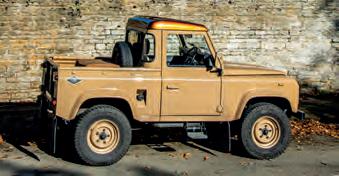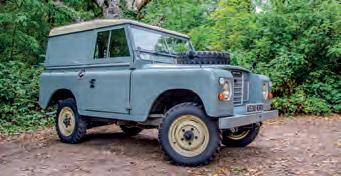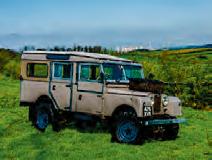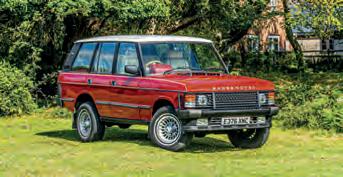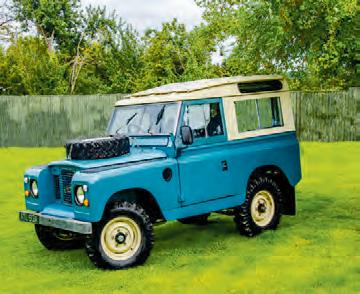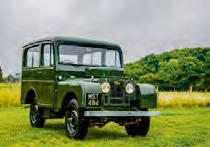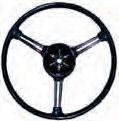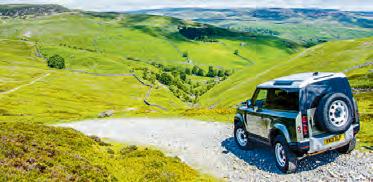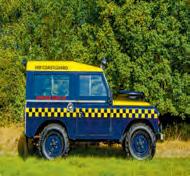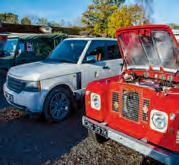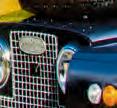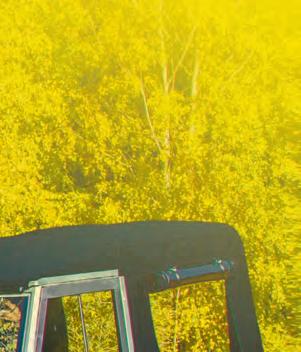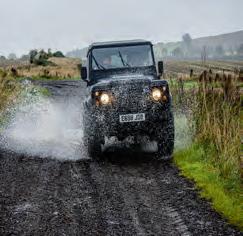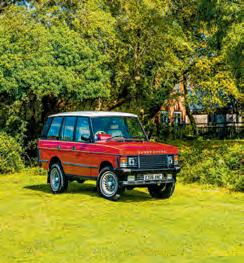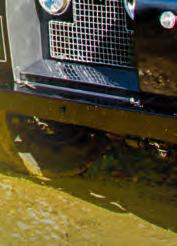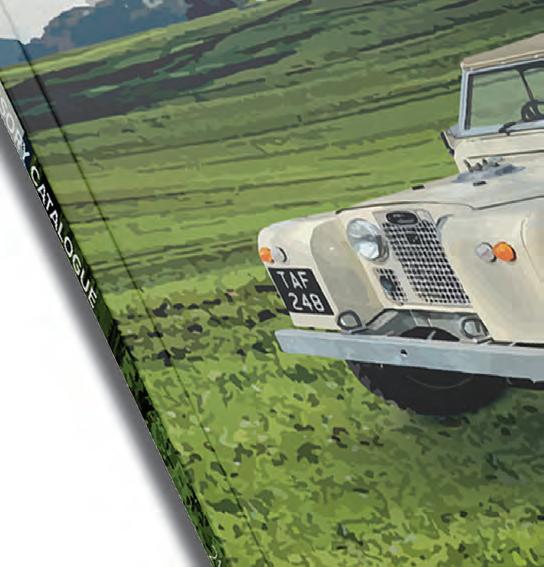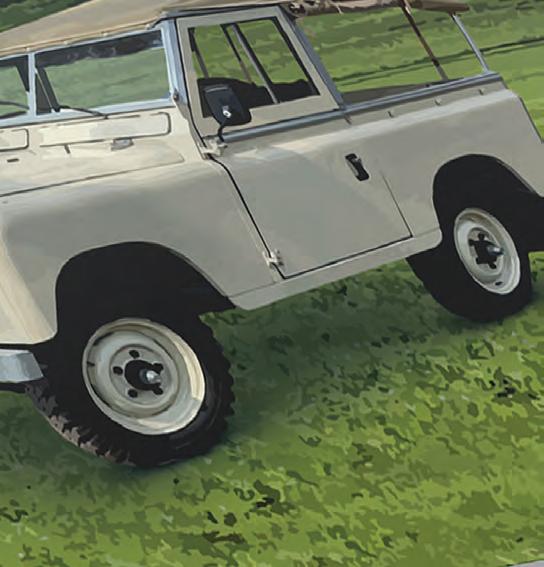




Light is Adventure. Let OSRAM light the way on your next adventure! Light is Adventure. Let OSRAM light the on next










Light is Adventure. Let OSRAM light the way on your next adventure! Light is Adventure. Let OSRAM light the on next






These spotlights deliver unparalleled brightness and exceptional light penetration. The robust aluminium mounting brackets are designed to resist vibrations and offer a wide range of adjustment options.
Each set includes a comprehensive wiring harness and switch, along with three bezel colour options: red, blue, and amber.
•7” (175mm) diameter
•10 - 32 volts
•1 Lux @ 682M
•6478 Lumens
•Colour temperature 6500K
•IP68 waterproof rating
•21 x 5w high intensity OSRAM P8 chips
•Diecast black aluminium alloy housings
•Interchangeable blue, red and amber bezels
•Wiring harness and switch is included
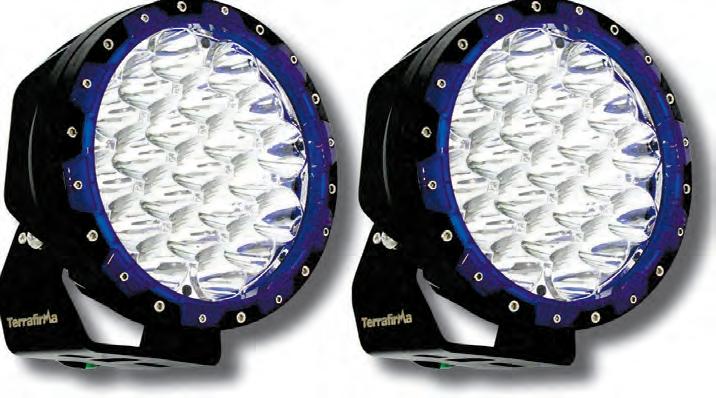
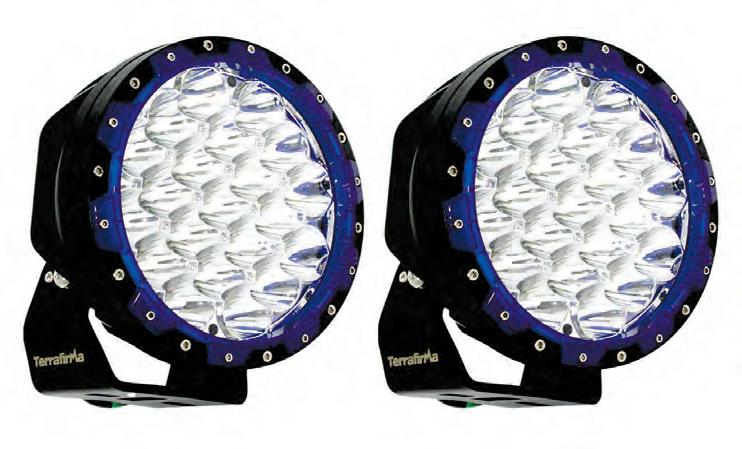



To advertise in The Landy, call our team on 01283 742969

We’re on Facebook: www.facebook.com/thelandyuk
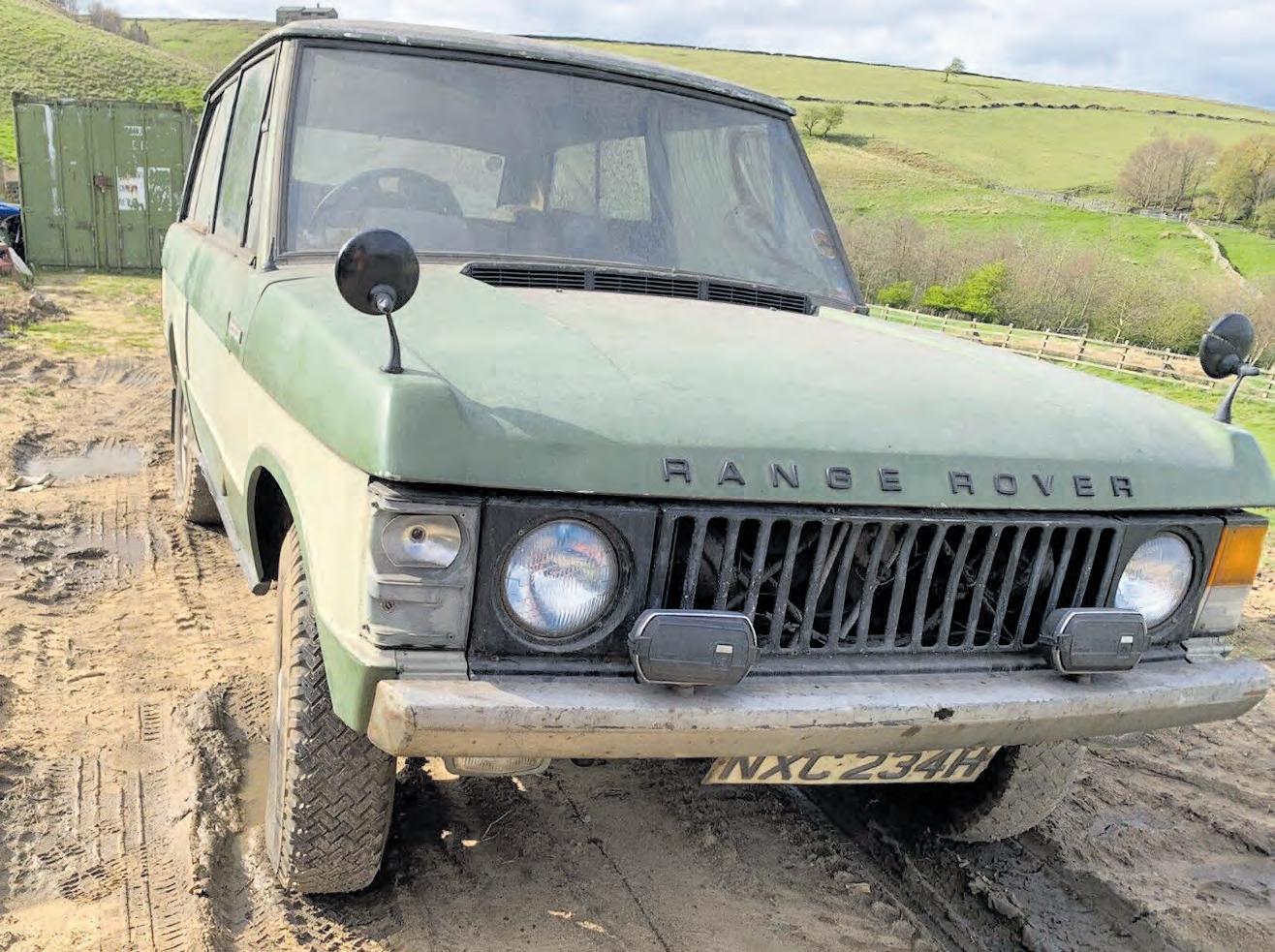
ONE OF THE VERY EARLIEST RANGE ROVERS HAS EMERGED INTO THE DAYLIGHT AFTER MORE THAN 35 YEARS. Registered NXC 234H, the 1970 Suffix A was the third pre-production model to be built after the initial run of 25 Velars; requiring full restoration, it has been owned since 2006 by lifelong Land Rover enthusiast Peter Butters but is now for sale at an asking price of £45,000.
Originally painted Masai Red, the Range Rover was manufactured
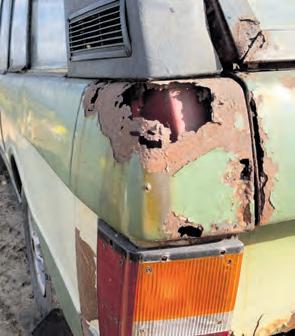




between 22 April and 28 May 1970. It was one of those used on the press launch in Plymouth but was later repainted in Lincoln Green – the story goes that it was chosen to be presented to the Queen on a visit to Solihull and loaned to the Royal household for a short period of time afterwards, and that Land Rover’s top brass felt that Prince Philip was unlikely to appreciate his new shooting party transport being bright red.
Evidence for this is to be found on the sides of the body under the rear quarter and wings, which remained in their original Masai Red when the vehicle was repainted. So too did the bulkhead, inner arches, battery tray and so on under the bonnet. Despite the vehicle’s condition, this is still readily visible today.
Just as the Range Rover has some outstanding tales to tell, so too does the man selling it. ‘I fell in love with Land Rovers at about the age of five,’ says Peter, ‘when my Grandfather bought a new Series II in 1959 – which
I recently found and intend to restore. Quite an heirloom, that.
‘In the seventies and eighties, I trialled a Land Rover 80-inch which I rebuilt in 1978 and still own today. This led to me buying complete motors from local scrap yards, less the valuable parts like dynamos and voltage regulators which at the time fitted a variety of vehicles and they had already sold in working order.
‘This resulted in me having one loft in my barn stacked with body parts, doors, wheels, axles, gearboxes and engines, as well as power take-offs and early front winches.
‘Along the way, I had acquired and repaired two 1949 80-inch Land Rovers to add to my collection. Over the years, I have had an ex-army Series II, a Series III and a Diesel Turbo 90. These were followed by a new Discovery Tdi Auto, four Range Rover CSKs (two of which I still own), a P38 and a further three Range Rovers plus an Evoque. So Land Rover really is in the blood!’
“Tea for me, four sugars and enough milk so it’s the colour of He-Man.”

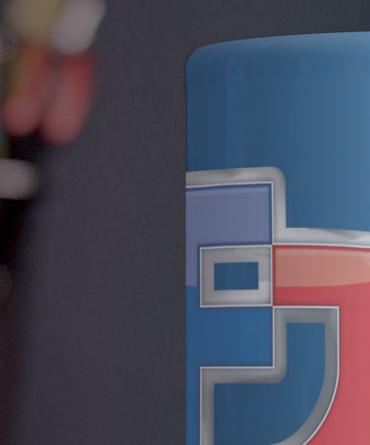

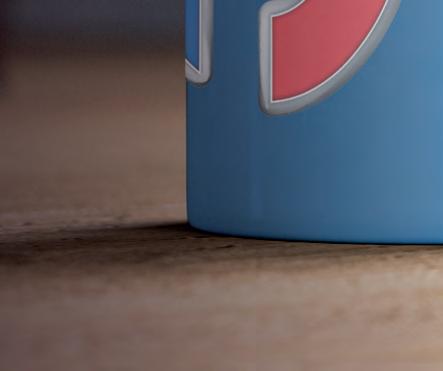

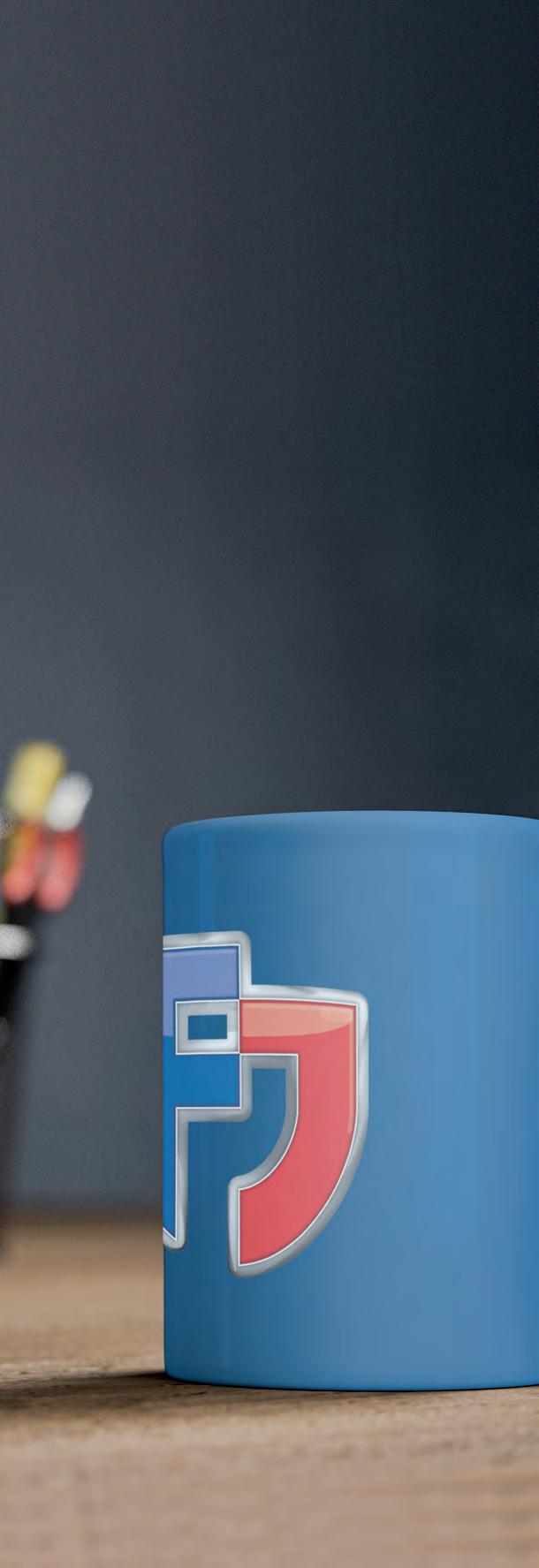




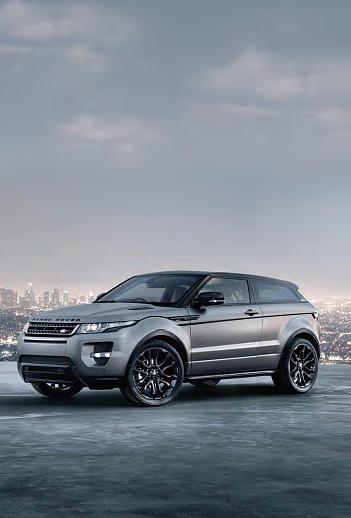
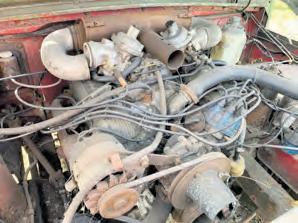

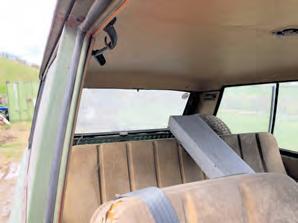
He wasn’t the only one in his manor who could say that, either.
‘My milkman and neighbour was the late Ken Wheelwright, the restorer of some of the best early Land Rovers. He would occasionally deliver our milk in a newly restored motor while doing a test drive at the same time!
‘I would get notes from him saying things like “I’ve borrowed a rotor arm and distributor cap from the 80 under the shed.” Ken regularly visited my loft of parts and once found a tropical grille panel there that was numbered for a pre-production 80. It ended up going on one of his pre-production restorations.
‘In 2006, Ken made me an offer for all the parts in the barn plus the two 80s, due to him wanting some new projects to work on. The money I received, plus a Range Rover CSK
I had in bits, were used in the deal to purchase NXC 234H.’
While it clearly has seen better days and is in need of very significant work, the Range Rover was, in Peter’s words, ’in better condition than I thought’ when he pulled it out of storage. Importantly, its major parts are all still there – and though all of them need to be brought back, none are in a condition to suggest that this will be an issue.
Peter also has a number of parts which he collected over the years to use in the restoration. ‘These include a very good rear tailgate, body sides in Masai Red, rear corner, overdrive unit and offside front light unit,’ he says. Not everything you’ll need by any means, but any part for a Range Rover of this vintage has to be seen as a rarity now.
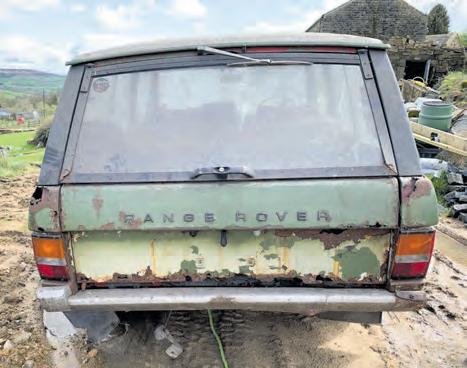
In addition, Peter says that the roof lining is in good condition – clearly not something you’d be expecting. And the original aluminium bonnet is in an ‘exceptional’ state – you’ll be doing pretty well to find one in any sort of condition at all, so this is a major bonus.
There are also some parts on the vehicle which are, quite simply, irreplaceable. These are the items which, to the eyes of an expert, mark the vehicle out as one of the very earliest. ‘The rear bumper is a pre-production one not found on production models,’ says Peter. ’The rear tailgate upper glass is plain, as found on the earliest motors. It has its original mats under the front carpets, and the Bendix servo is only found on the earliest production models.’
If you’re just after any old Range Rover to tinker with or, worse, abuse, the price of this one will of course have put you off instantly. For someone who recognises the historical value of what they’re looking at here, however, this is an opportunity which, it’s fair to say, is highly unlikely ever to come up again. There’s a huge amount of work to be done in restoring NXC 234H – but once the job is done, the vehicle will be verging on priceless.
This is a historic machine in its own right, a chapter in the story of Land Rover’s relationship with the Royal family – and most importantly of all, almost certainly the earliest Range Rover you’ll ever get the chance to own. It’s one for the connoisseur, not to mention the expert. You’ll find it listed in the classifieds on page 28 of this issue – and one day in the future, you’ll find it starring at Land Rover shows the length of the country.



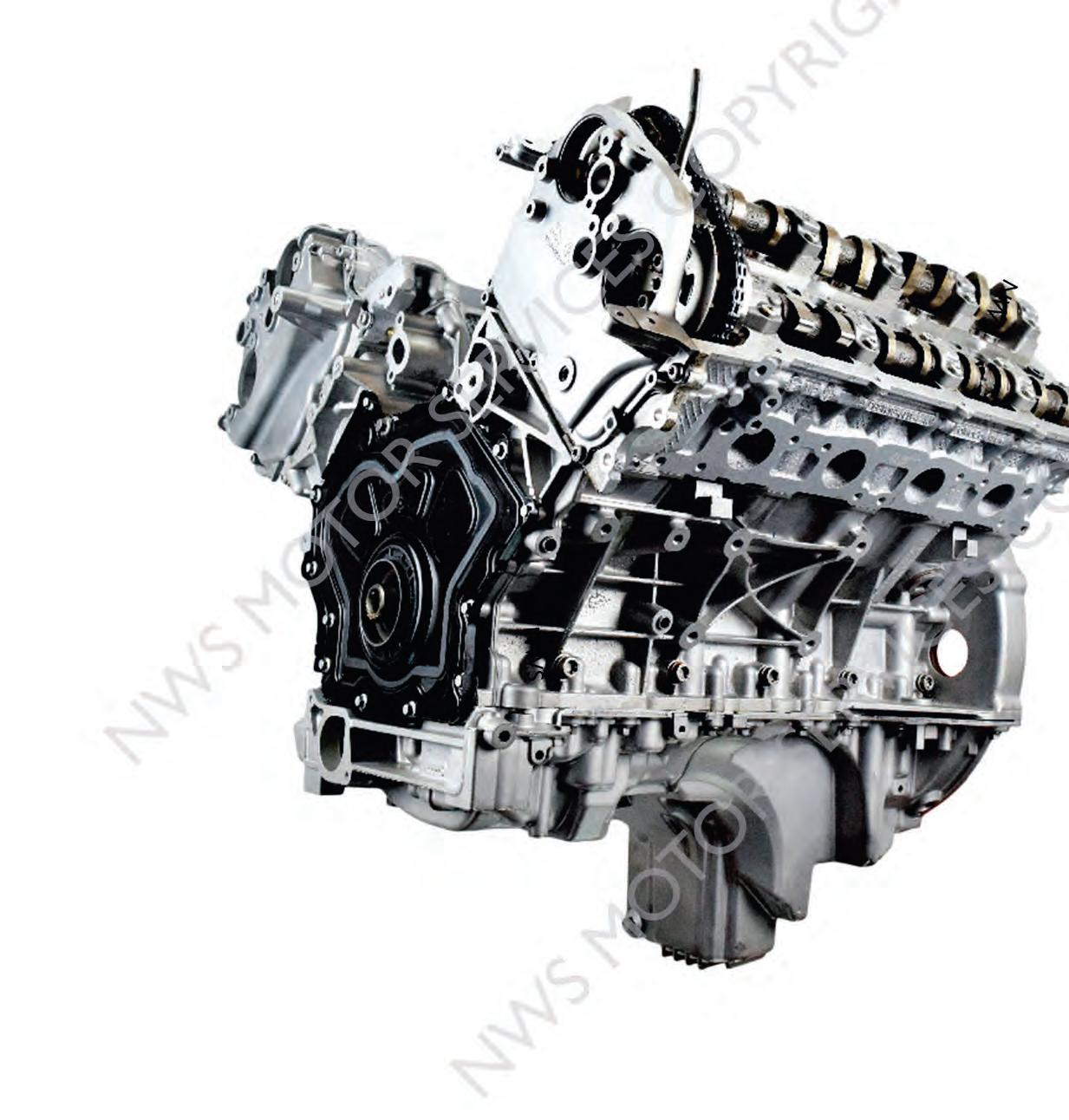
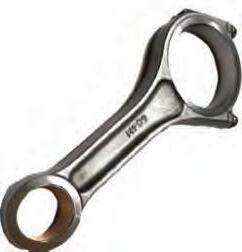
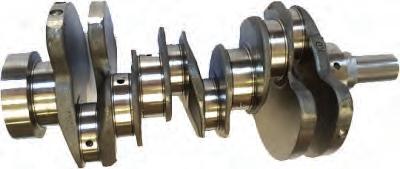
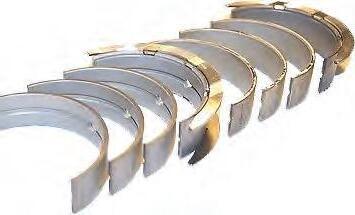
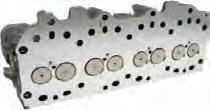
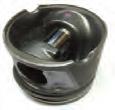
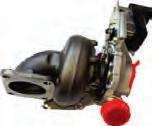





Automotive reveals its latest celebrity customer as Olly Murs takes
You’d expect a graduate of the X Factor to be the epitome of class and good taste, and sure enough Olly Murs recently treated his Defender 110 to an Urban Automotive makeover. This isn’t a new-shaper in the mould of the vehicles Urban has lately started to see as its stock in trade, though – being a man of the people, the singer and TV star gave the treatment to his old-school Utility Wagon.
Murs and his wife recently became parents for the first time, and the latest celeb on Urban’s books says he’ll use the vehicle for family activities such as ‘staycations, camping holidays and tents.’ It was previously equipped with 16” alloys, a raised air intake, tubular rear light guards and a low-profile roof rack – but these all went by the board to help prep it for life as a family adventure wagon, to be replaced by lowered suspension, 18” alloys, LED lighting and a ‘Best of British’ exterior design pack.
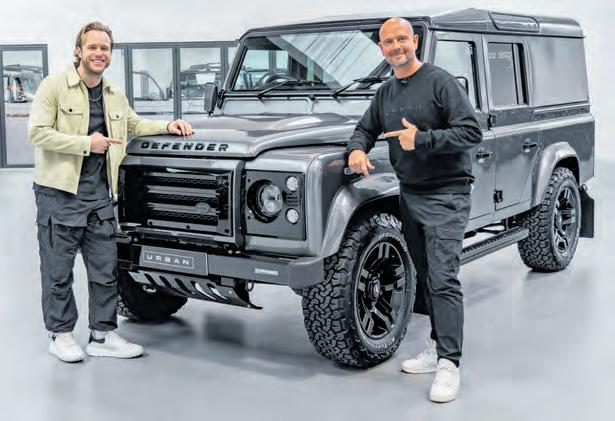


Urban Automotive says its team also carried out a light restoration and paintwork refresh, ‘leaving the Defender 110 looking even better than when it originally left the factory.’
You can see how much better in the pictures. Urban, whose other famous clients include Jesy Nelson, Scott Disick and Marcus Rashford, fits a wide range of interior and exterior customisation options at its Milton Keynes HQ. Look out for them this summer at a camp site near you.
Left: Olly Murs looks pretty happy with his reworked 110. Right: Before and after – Urban Automotive binned the snorkel, roof rack and 16” tyres to create its kind of adventure truck




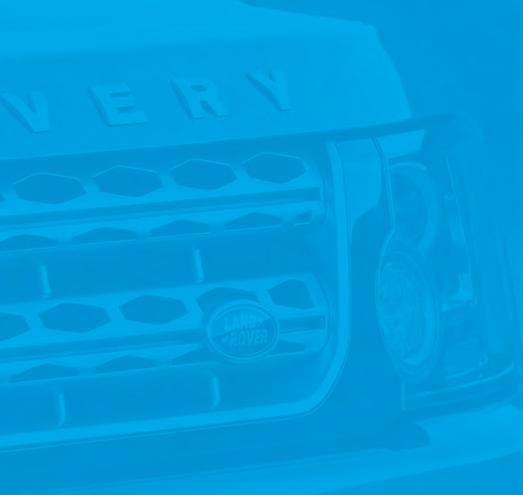


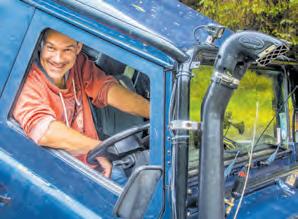
For the last decade or so, every time I’ve gone looking through Defenders for sale I’ve found myself staring at an endless list of 90s and 110s with trick paint, alloy wheels, leather seats and more shiny trim than the average hot rod. It’s been very clear that blinging them up is the fashion. But fashion is temporary. Just ask anyone who got a haircut in the 1980s. And there’s a new trend among Land Rover owners.
Actually, it’s more a trend among the motoring world in general. You may well have started to see Passats and Mondeos going about with roof tents on top of them, and that’s a symbol of society’s new found (or re-found) passion for the outdoors. Camping is in.
Of course, camping has never been out if your version of the Defender life involves exploring the world. But now the rest of humanity has discovered the simple pleasures of being parked up in the middle of nature, cooking over an open fire and preparing to sleep under canvas on top of your vehicle, you can congratulate yourself on being a trend setter. They all think they’ve discovered something new – but canny old dogs like you were doing it twenty years ago.
People have been saying since Covid that ‘staycations’ were the new thing, and camping is a cost-effective way of going on holiday if you’re one of the many whose exciting new mortgage payments mean hotels and cottages are now something people who work in finance get to enjoy instead of you. So you can see why it’s come into fashion as a way of getting away from it all – but I wasn’t expecting it to become a stylish way of dressing up your family car too. Maybe I should have, though. Land Rovers were always cool, even before the bling craze kicked off, and things like roof tents and jerry cans are part of the reason why. Now that the gone camping look is the height of four-wheeled chic, Defenders are the definitive example of the latest thing in automotive fashion. And they were there at the start of it, so they’re more credible than ever. And no surprise there. After all, as they say, style never goes out of fashion.
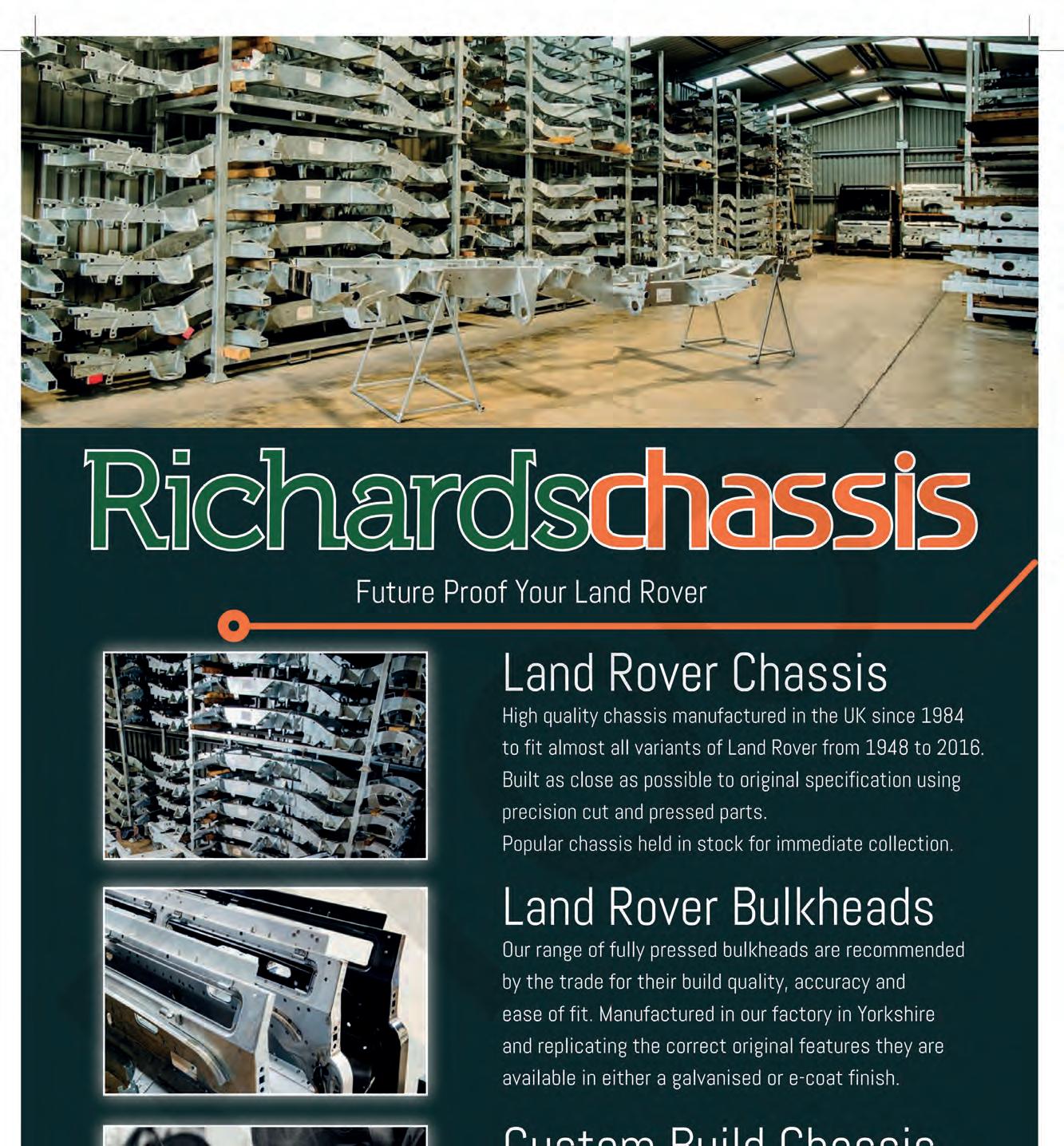
Alan Kidd, Group Editor alan.kidd@assignment-media.co.uk












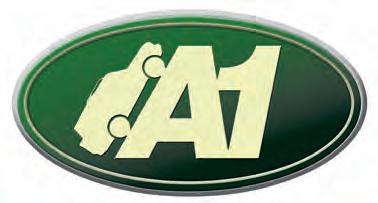


THERE’S NO SHORTAGE OF SPECIALISTS READY TO HELP YOU CONVERT YOUR DEFENDER TO ELECTRIC POWER. A few threaten to be affordable: most want you to combine the work with a major restoration that turns the vehicle into a cool, modern lifestyle statement. But none of them have been able to do it using in-wheel motors.
which takes five hours to top up the battery to 100%. Ideal if all you’ll be doing is short journeys and can recharge overnight, however on vehicles designed to be used for longer journeys an optional 50kW fast charger can do the job in 90 minutes.

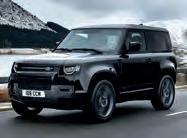


Until now. Step forward Bedeo, ‘which says it’s ‘aiming to decarbonise our transportation systems with the use of retrofits versus buying a brand new vehicle in the quest to reduce emissions.’ A noble goal.
Bedeo is a group of companies which includes Protean Electric, whose in-wheel motor (IWM) technology is at the heart of the new Reborn Electric: Icons range. The company says the conversion is suitable for any vehicle, however it chose the Defender as a flagship with which to launch the service, presenting it aboard a formerly Td5engined 110 station wagon.

A common anti-electrification argument is that EVs are heavier than conventionally powered cars, however Bedeo says its motors, batteries and charging hardware weighs no more than the diesel engine and gearbox that’s removed from the vehicle. Said battery is a 75kWh unit, giving the Defender an estimated range of 153 miles using the WLTP standard.
The conversion comes as standard with a 22kW on-board charger,
Of course, range estimates are based on a standard vehicle, however Bedeo says its technology ‘empowers customers with an unparalleled level of customisation.’ The company plans to work with partner businesses which will offer its EV conversion as part of a wider restoration or upgrade process similar to those which are already available from other sources. The IWM feature is what makes it unique – however as with anything else, a set of 40” mud tyres and all that goes with them will inevitably have an effect on the amount of battery power it takes to shift the truck around.
‘The classic car community has warmly embraced the idea of converting their beloved vehicles to run on electric power,’ says Bedeo boss Osman Boyer. ‘However until now, none have ventured into utilising in-wheel motors to tap into the advantages of weight reduction and engineering enhancements.
‘Through our Reborn Electric: Icons program,
we are committed to maintaining the original car’s kerb weight, charm and driving dynamics, while ensuring easy maintenance and delivering the benefits of electrification. For the Defender, and other models to come, this means zero tailpipe emissions, zero noise and the preservation of the nostalgic driving experience we all cherish, now brought into the 21st Century without sacrificing its essence or adding unnecessary, bulky weight.’
It’s safe to say that not everyone in the classic car community has warmly embraced EV conversions, and the same can be said of Defender owners. Still, this is the way the world is going – and with the ability to last many times longer than most everyday cars, the Defender is the natural choice to take it there.
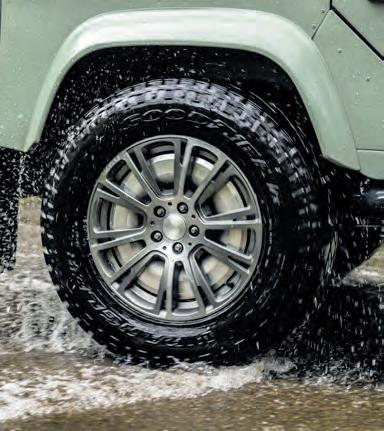
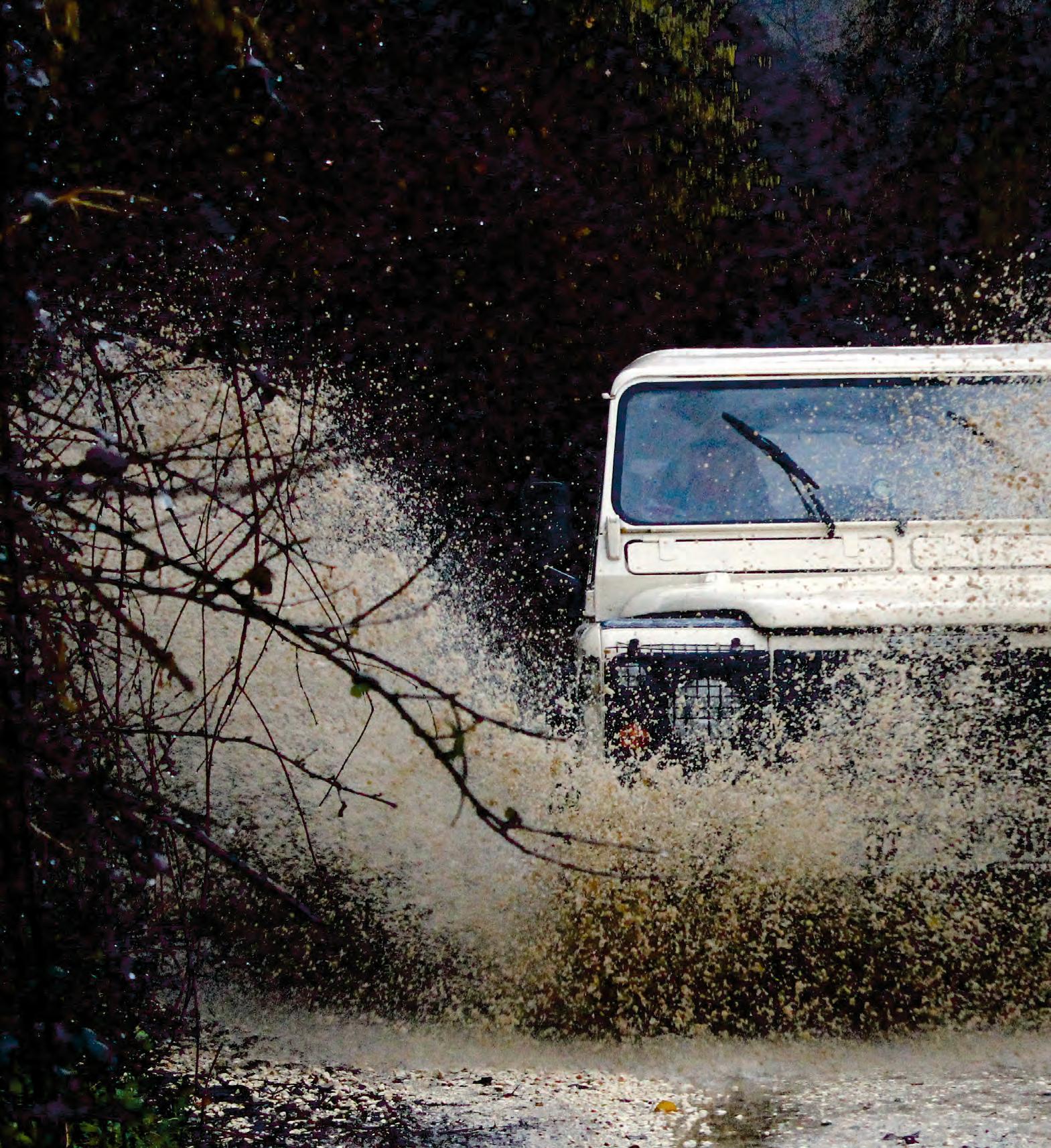
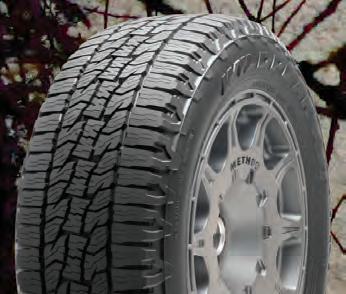



WILDPEAK A/T TRAIL

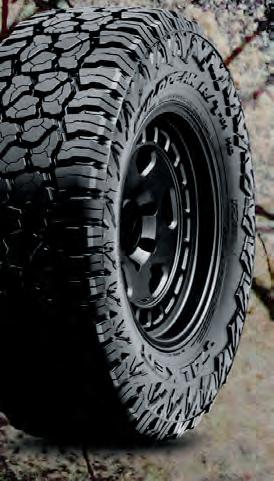
WILDPEAK R/T01
Wildpeak A/T Trail - Rugged Crossover Capability
Built for adventure delivering rugged off-road capability without compromise on the open road. Featuring the Three-Peak mountain snowflake, the Wildpeak A/T Trail encourages adventure seeking crossover owners to discover true all-weather capability.
Wildpeak R/T01 - Bold, Rugged Terrain Capability
Developed for 4x4’s and SUV’s this tyre sets the standard for the new rugged terrain tyre category. Providing the tenacious off-road traction of a mud tyre while retaining the tread life and stability of an all-terrain, professional Off-Road tyre with POR marking. For further information and to find your local stockist please visit www.falkentyre.com/en or www.4site4x4tyres.co.uk






. It’s not until you’ve had one that you realise just how annoying they are. And everybody who’s got one wants rid of it.
The good news is that AlliSport offers a wide range of EGR Removal Kits. This one, for the Td5 engine, comes in silver or black and is suitable for Defenders and Discoverys with or without a boost gauge.
The unit is TIG welded by hand and has a CNC milled 6mm aluminium mounting flange as well as a swaged tube to stop the connected hose slipping off under boost. AlliSport promises that it won’t interfere with the engine’s ECU system or otherwise fire up any warning lights, and that as well as keeping hot, dirty air out of the engine (where it pulls down power output and results in black smoke) it will remove the restriction on air flow created by the original-fit EGR valve. This is significant, in particular on engines from 2001 on.
On earlier engines than this, it’s possible to delete the EGR without touching the exhaust connections. Later units, which were fitted with EGR coolers, need the exhaust outlet to be blanked off at the front of the cylinder head, and kits for these engines come with a 6mm stainless steel plate to let you do just this.
AlliSport promises that the kit is simple to instal, with just a bit of bolting up and connecting of hoses required. A lot less hassle than getting rid of a high-maintenance girlfriend, certainly… and an awful lot better value for money, too.
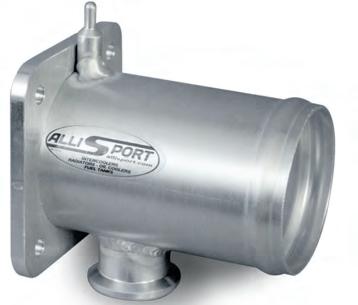





























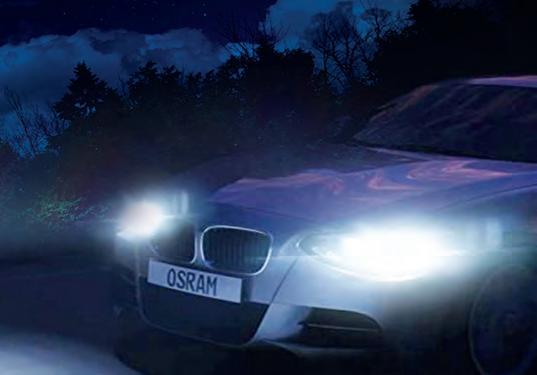























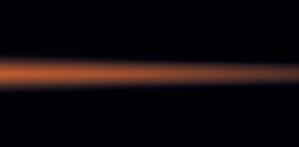
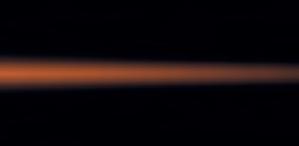







Cynghordy Llandovery Carmarthenshire, SA20 0NB
Tel: 01550 750274 e-mail: info@cambrianway.com
www.cambrianway.com
Green Lane Holidays in Mid Wales
Family run guest house and self catering cottages with spectacular views, en-suite bedrooms, comfortable lounge bar and excellent home cooked food. Pressure washer, drying room, map room with local lanes marked, on-site 4x4 course, guides and GPS hire available. A very popular venue for both individuals and groups of 4x4 enthusiasts

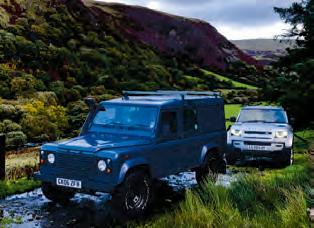
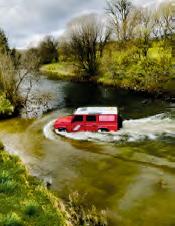
Special Offers for The Landy Readers 2022 Prices held until February 2023
10% discount off accommodation between 25th November 2022 and 28th February 2023 by quoting TL10 when making booking direct by phone (excluding Christmas & New Year & subject to availability)
Price: Price: £67.24 inc VAT
Available from: maltings4x4store.co.uk, TF8001
THE DEFENDER’S REAR DOOR IS A BIG, PLAIN THING that doesn’t do very much apart from just be a door. That goes for the new-shape model as well as the old one, so it was inevitable that before long, the aftermarket would hit on ways of making it more useful. That’s what Terrafirma has done with its Rear Door Molle Style Organiser, which gives you somewhere to secure loose items so they won’t jump up and bite you first time you try to drive down a set of rock steps. To be fair, the new Defender is probably better than the old one at not making this kind of off-roading feel like you’re a single

grain in a huge salt shaker, but keeping everything tried down as one of the basic rules of off-roading so something like this is always money well spent.
Price: Price: £83.14 inc VAT Available from: maltings4x4store.co.uk, TF8000
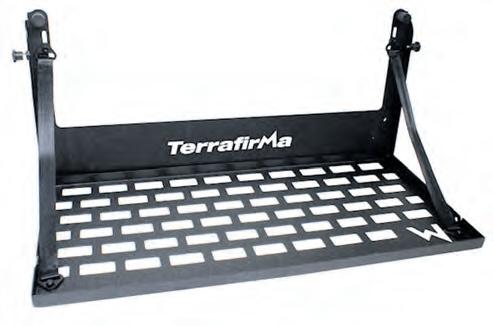
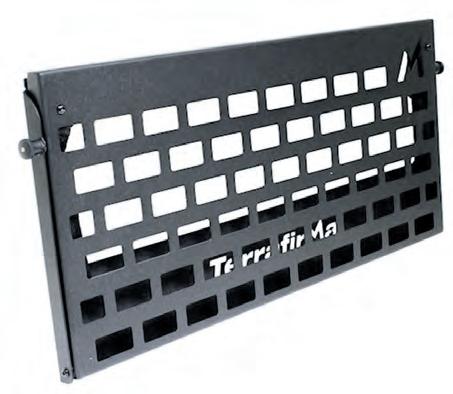
IF YOU WANT TO MAKE YOUR DEFENDER’S REAR DOOR EVEN MORE
designed to give you a solid surface on which to prepare food and
www.fourplus4-leeds.co.uk

everything you need to fit it, including instructions.
Price: 501.85 inc VAT
From: maltings4x4store.co.uk, TF8025
IF YOU’VE BOUGHT A DEFENDER IN THE LAST FOUR YEARS AND THE THING THAT’S TURNED UP HAS LOOKED A BIT ODD, the good news is that it’s meant to be like that. Not so good news is that however much you bash it, you’ll never make it look like a proper one. Talking of bashing it, though, at least you can press a button and make it lift up from the ground so you won’t clatter its underside against a rock or tree stump. What do you mean, the same rock or tree stump your mate has just cruised over in his old-shape 90? Shhh.
Underbody protection was a big deal for old Defenders and it’s going to be a big deal for new ones, too. In fact it already is. Witness Terrafirma’s 6mm Alloy Underbody Guard Kit for the vehicle, a two-part job which located on to existing holes in the vehicle’s structure and has the strength to take whatever hits you put on it. ‘Ideal for keeping the underneath of your Defender protected whilst over rough terrain,’ says Terrafirma agent Maltings 4x4, and it’s very hard to disagree.
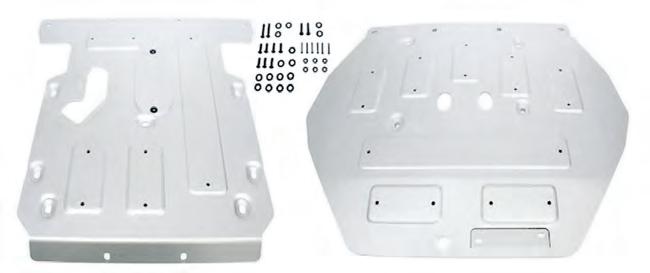


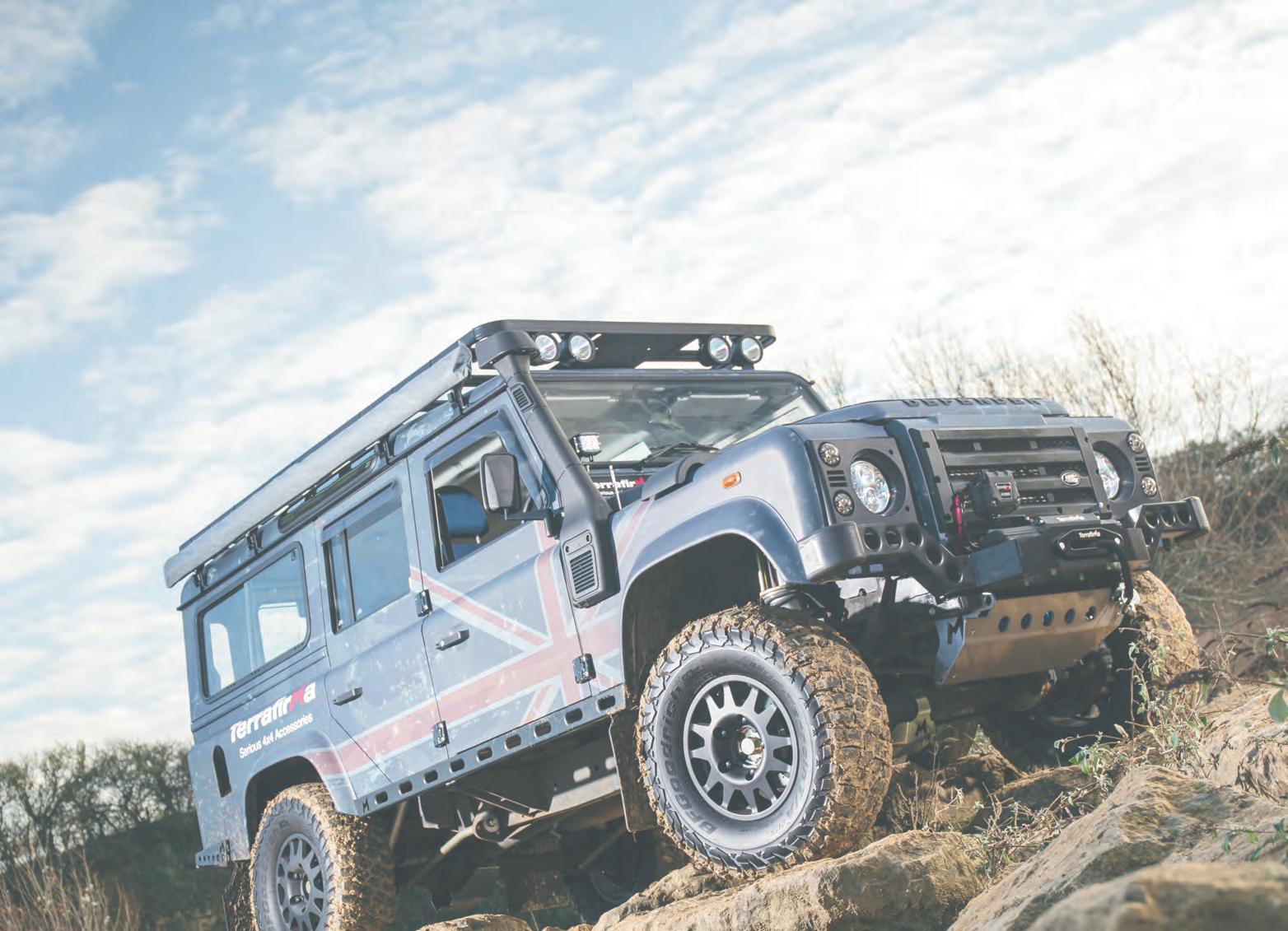





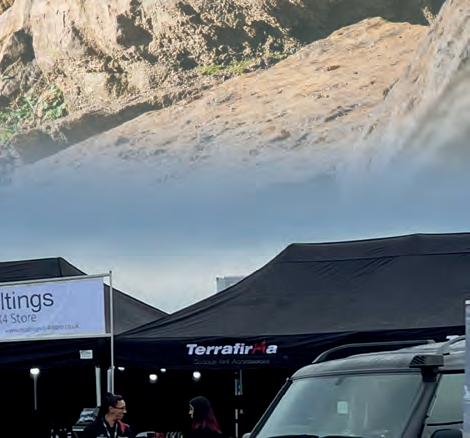
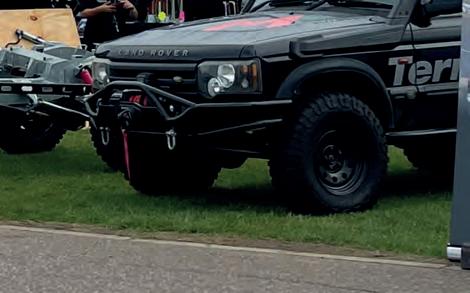
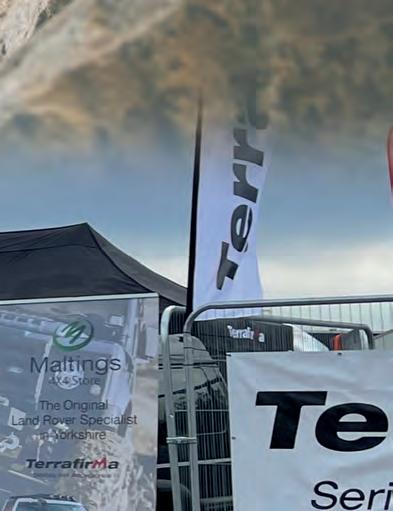












To advertise in The Landy, call our team on 01283 553244

We’re on Facebook: www.facebook.com/thelandyuk

www.thelandy.co.uk
Orange Crush is a Range Rover monster truck that won a string of trophies on the show scene a decade or so ago. But beyond the huge tyres, it’s a rarity with the body of a CSK and the Suffix A identity of a true original
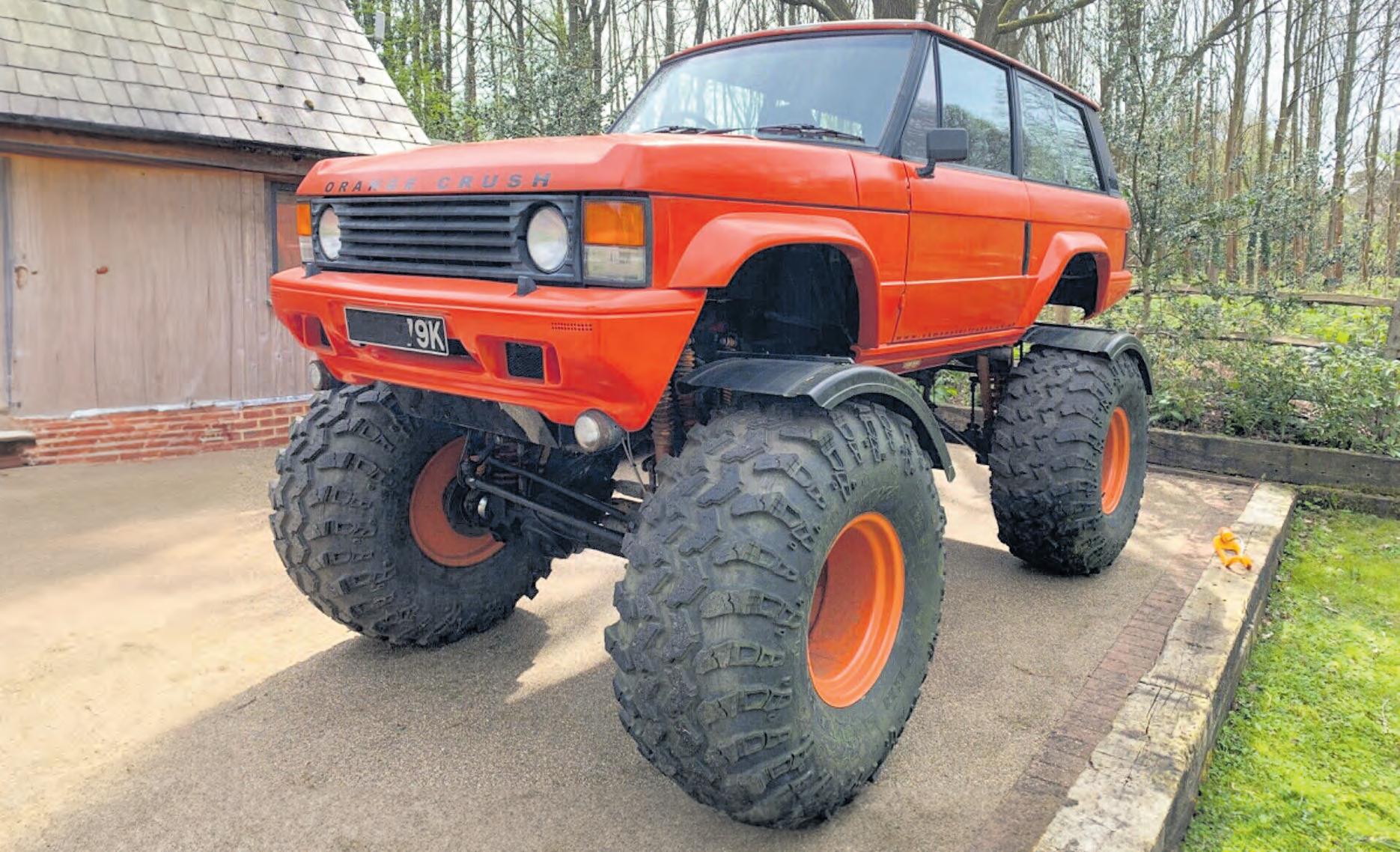
People who are into off-roading have a certain kind of relationship with monster trucks. You kind of recognise that they’re cut from the same cloth as your own vehicle… suspension lift, big tyres and all… but you don’t want the outside world to think that’s what you’re all about. We’re off-roaders, dammit, these big tyres aren’t for show you know, we understand you can have too much lift, leave us alone, etc etc.
Except those big tyres are for show most of the time, and when you go to an RTV trial and some old boy on 6.0016s drives his completely standard Series II everywhere your butch 90 can go, you get all yeah but no but yeah about the fact that your 37” Super Phallus Radials were absolutely necessary cos you know there’s that green lane near you and one time my mate Gaz
got down it and I was still on standard 235s and, and, werp, cringe… Which is why off-roaders don’t like monster trucks. If you’re not into off-roading but you are into Land Rovers, on the other hand, you might not care much one way or the other. Monster trucks will be about as relevant to you as top fuel dragsters. Except you might bristle a bit at this one, because that’s a Range Rover CSK up there.
Pause while you wipe up the cornflakes you’ve just spluttered everywhere in indignation. Let’s go again, shall we? Actually, maybe I ruined your breakfast unnecessarily there. The identity is not that of a venerated classic. But it could be said that the body is.
Wot? ‘The two-door shell was bought new from Land Rover direct in 1992 or 93,’ explains Sean Parker. ‘So it could be classed as a CSK shell.’ Perhaps
a little bit of a stretch, but if you know your Range Rover history you’ll know what he means. It’s a bit like Santa – if you want to believe, well then it’s true. So, we have a man who bought an entire shell from Land Rover more than 30 years ago. This is going to be a project with a bit of a story to it, then. And the first part of the story… he put it in a barn and next thing you know it was 2004.
By now, the vehicle is in its thirties. Not the shell, the chassis and therefore the identity, which dates from 1973 and makes this doubly confounding for classic Rangey sniffers as we’ve now got a sort-of CSK perched on a suffix A identity. ‘Although not much of the donor is left,’ says Sean, ‘to me I think the shell and registration are where the main value is. Kingsley Cars will sell a bare shell that’s been made up
from new panels for £24k, so it’s hard to value what I’ve got as it’s a genuine bodyshell from Land Rover.’
Genuine and unmolested, too, save for welding up the openings for the shock turrets on the inner wings.
But what’s this talk of value? Sean is currently thinking the unthinkable and considering whether to strip the Range Rover for parts. ‘I’m currently in the throes of what to do with it,’ he admits.
‘Do I break it for spares or spend a month of Sundays getting it looking
A1 again, or sell it as a complete truck which can be driven away?’
Well, we’d pitch in by suggesting that while the shell and registration are indeed where the main value lies, in terms of what’s going to get someone to put their hand in their pocket, you don’t have to spend much more time listening to Sean to understand what
really makes the truck worth its salt. ‘We have spent 1000s of man-hours on this project… eaten over £1000 worth of take-aways… drunk over £1000 worth of beer (well, one of us has anyway!) We’ve each smashed our heads and other body parts at least 10 times, lost our tempers, well, just once or twice… Grown a few more grey hairs… and lost some. Celebrated two Christmases and two birthdays each… a wedding… and a few close divorces!’
The ‘we’ in question are Sean himself plus Chris Caluori and Ian Standen. ‘We’ve used so much power, we’ve added an even bigger hole in the ozone layer!’ Sean continues. ‘We’ve put far too much money, effort and time into this truck. But most of all, a group of mates that have known each other almost all our lives have built a monster truck out of an old British legend.’

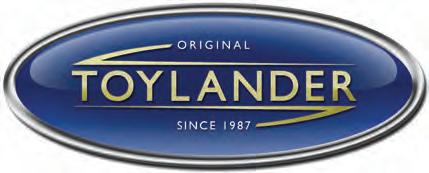





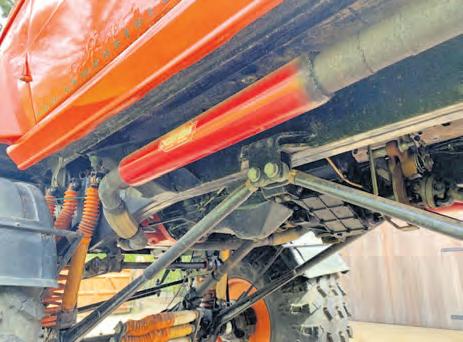
As the above suggests, it took two years for the trio to see the Rangey through from bare chassis to showready condition (it took first prize first time out, as if you didn’t just know that anyway). That was in 2008, since when Sean reckons it might have covered 500 miles in total.
That’s 500 miles on a 5.7-litre Chevy V8. No, not some old hunk of rust fetched out of a dumpster in Alabama – this was a brand new crate engine, bought in 2004 and mated to the Range Rover’s own four-speed auto box using an Overfinch adaptor. The transfer box is still in place, and custom props (plural – it’s still four-wheel drive) spin the diffs in a pair of modified Range Rover axles. These in turn are bolted up to a set of custom tractor-style wheels wearing 49.00x21R20 Irok Super Swampers – ‘the largest road legal tyres you could buy at the time,’ says Sean.
You’d assume that with all this going on, between the engine note and tyre noise you wouldn’t be able to hear a stereo but Sean fitted one anyway. He




also made a full set of custom door cards and rear inner trim, fitted a 1993 dashboard and finished the exterior with a set of genuine Brooklands bumpers, which he modified to mate with the extended wheel arches, setting the seal on a monster that could be driven to shows and admired once at them.
And it was, for a while, but now here we are a decade and a half later and the Range Rover is freshly into its second half-century but facing an uncertain future. Is Sean going to end up deciding to take it back to its show-winning state, or will he go after the money and pull it apart? Or will someone else take it on and turn it into their own vision of the perfect Range Rover?
If it’s to become a classic, it’ll need to become two classics. A ’73 identity and a ’93 shell, even a two-door, don’t add up to much in the eyes of any scrutineer we’ve ever met. Though if you’re like us and consider the owner-builder community to be intrinsic to what the Land Rover vibe is all about, you could certainly argue that a Suffix A with a late body and a Chevy lump is actually
very appropriate. Drop it back down to a more normal height and you’ve got a Range Rover that’ll make the right people ask the right questions while going over the head of a majority who don’t know a history sleeper when they see one. Just promise us you won’t turn it into an off-road beater…
And there we are talking about off-roaders again. And you know what they’re like with monster trucks. We’d take Orange Crush back down to its original ride height, lose the big arches and Brooklands gear, put it in paint from the early 70s then stand back and watch while people try to figure out what they’re looking at. And then we’d set off at a nice slow pace, listening to the burble, and get down to the business of finally running in that Chevy V8. The possibilities in this Range Rover are endless – and so is the potential.
Thanks to Sean Parker for his help in compiling this article. His Range Rover is currently listed for sale at £22,500 in our classifieds section – you’ll find it advertised on page 28 of this issue
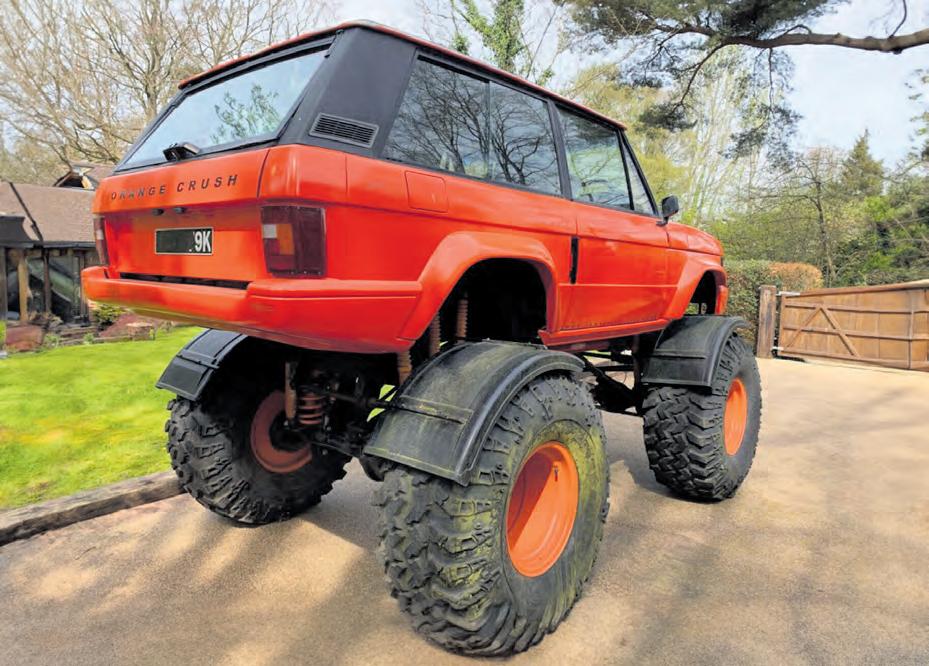


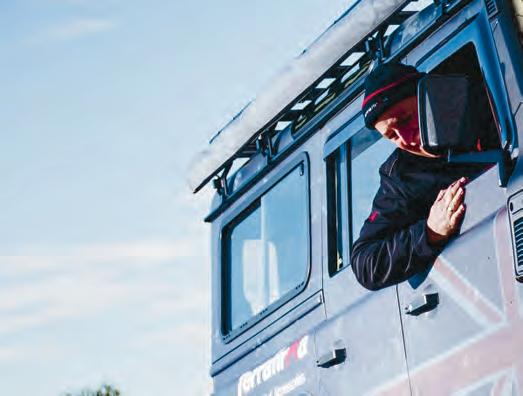






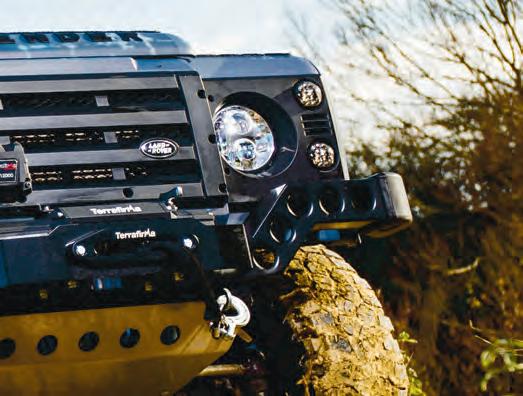






















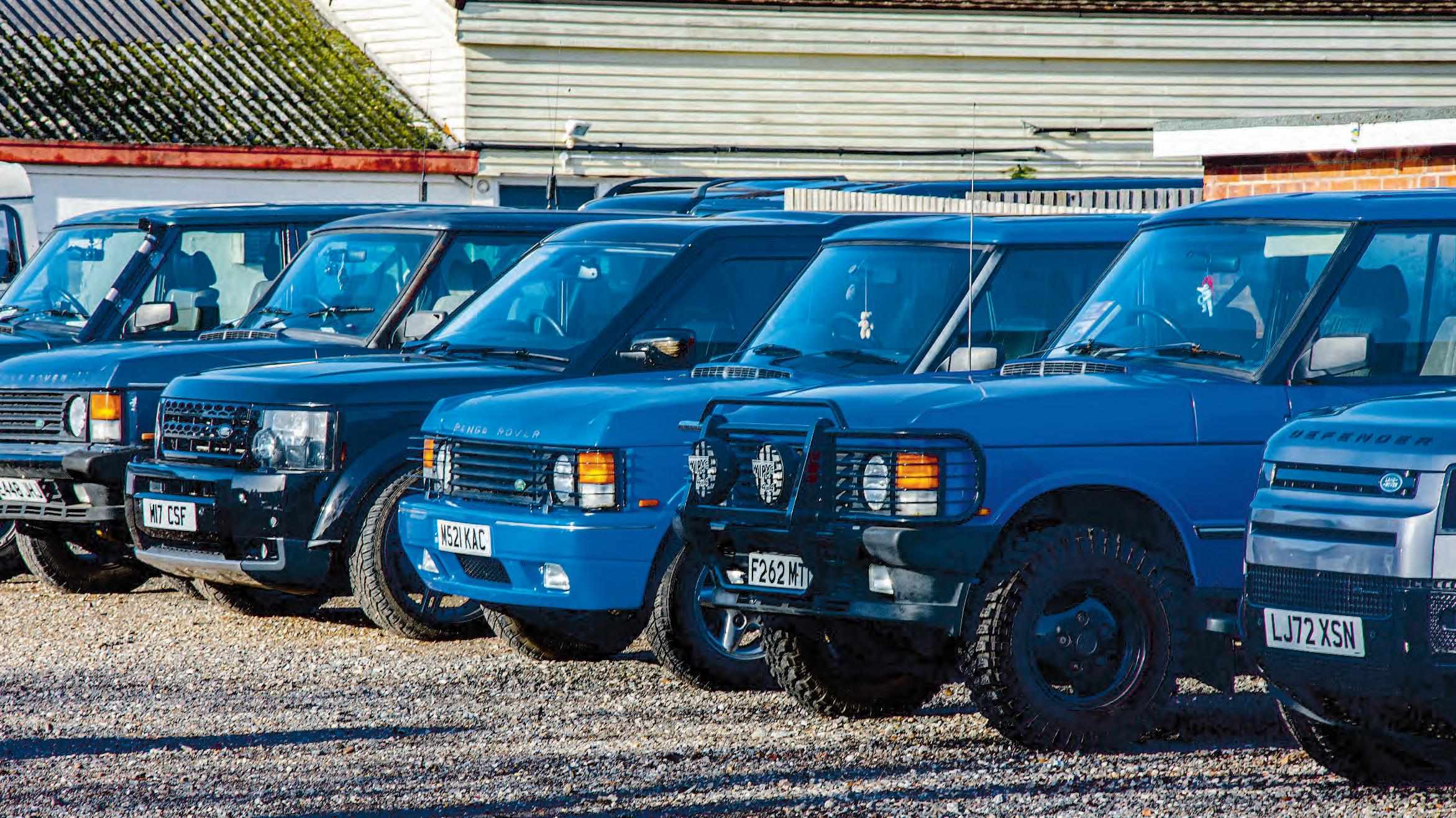








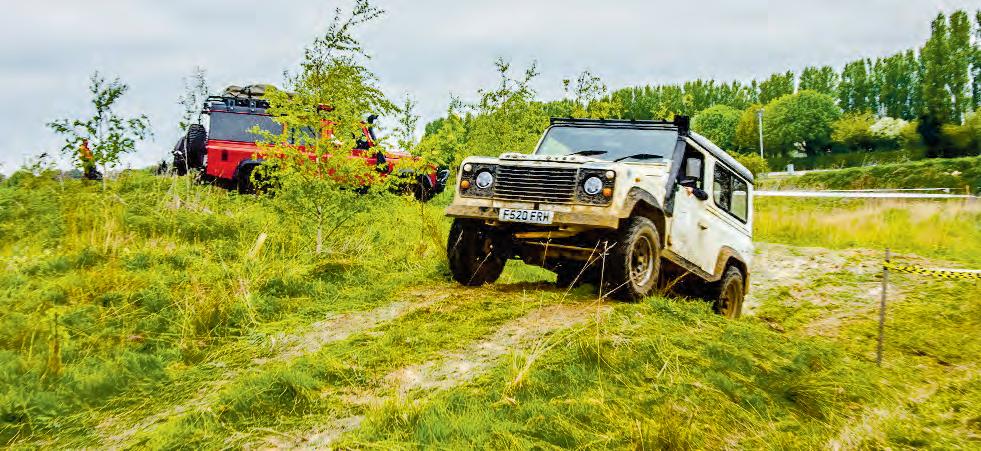
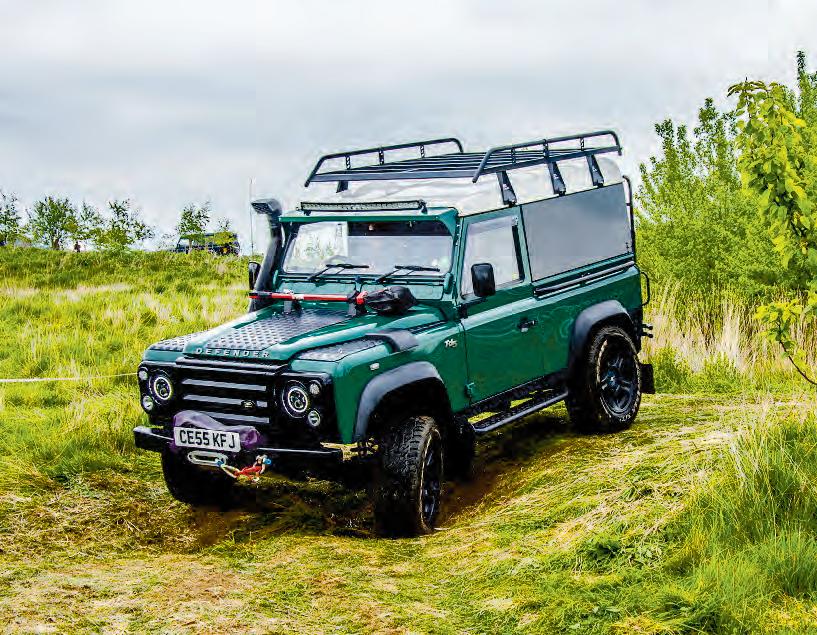
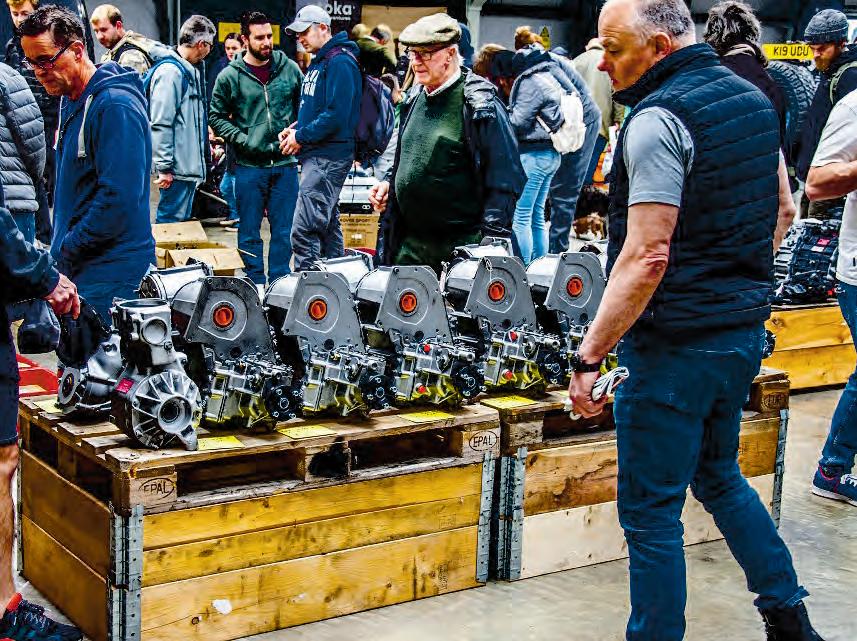



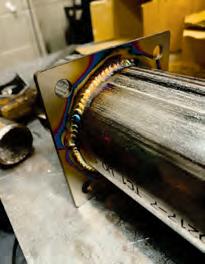
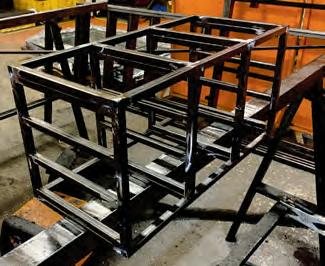

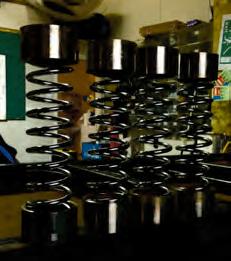
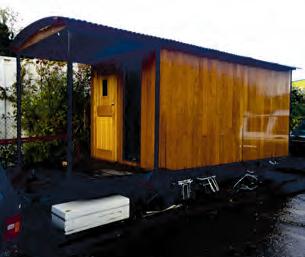

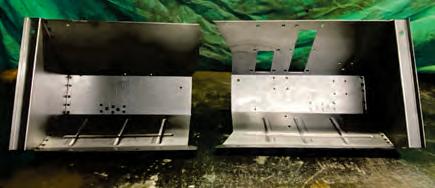

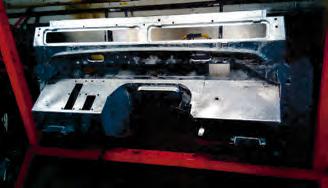
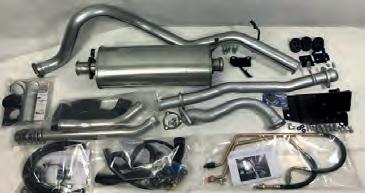
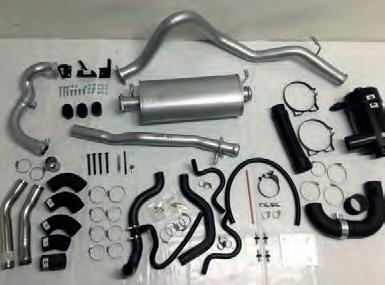
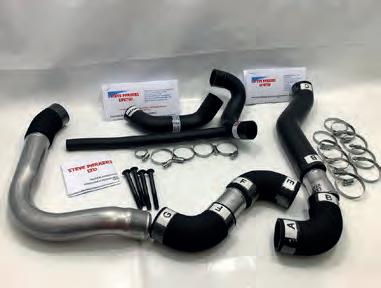

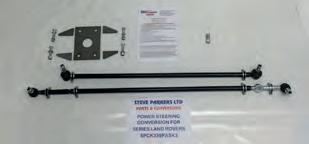



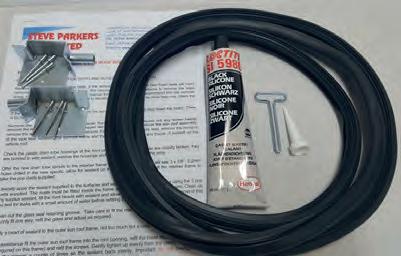
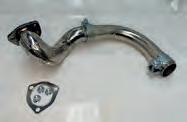
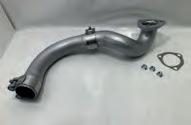


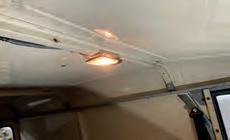

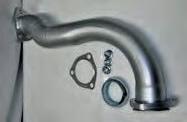
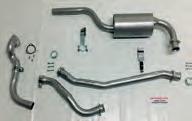
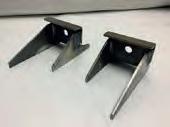
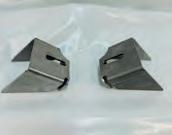
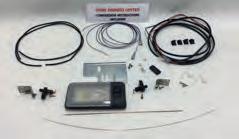




To advertise in The Landy, call our team on 01283 553244

We’re on Facebook: www.facebook.com/thelandyuk

For the last ten years or so, people have been into look-at-me Land Rovers. Paul Wilde just wanted a 110 he could live in while exploring the world – but in doing so, he built a Defender you REALLY want to look at…

For much of the last decade, Defender building has shifted its focus from purpose and practicality to looks and lifestyle. As the vehicles’ values went up and up without any sign of ever reaching a ceiling, demand for blinged 90s and 110s appeared unquenchable – the result being that now the market has adjusted itself to a slightly more sane position, it’s flooded with shiny Land Rovers rocking big alloys and trick paint.
Shiny Land Rovers do look good, if you’re into that. And some of the trucks the bling artists created during that period really were quite mind-blowing. As that market moves relentlessly upwards, however, and gets more and more formulaic as a result, individual builds are moving back in the direction of purpose and practicality.
A good Defender is still a pretty valuable thing, however. So we’re not seeing a return to the days when people would cut one up and go bashing it off trees at Tong or Slindon, or CCV-ing its brains out with their local Rover club. Instead, the new zeitgeist in Defender building is to turn a 110 into a longrange camper or expedition vehicle.
And guess what? If you want people to look on admiringly, should you bolt on all the gewgaws you can find and
fit a set of alloys so huge the tyres around them look like rubber bands?
Hell, no. They might look on, but they’ll be thinking the same thing they do when they see a slammed BMW with a popcorn exhaust; the details may change, but the W always stands for the same thing.
No, if you want people to look on admiringly there’s nothing like an expedition build to do it. Just ask Paul Wilde, who built this late 2.4-litre Puma 110 with a view to exploring Europe and Africa.
‘Be prepared,’ he says. ‘If you are thinking of owning this Landy, you will always get stopped, always meet new people and forever be the centre of attention.’ Yeah, he’s selling it. Or to put it another way: Yeah! He’s selling it!
More of that at the end. No, don’t skip. You’ll miss the good stuff.
And there’s a lot of good stuff about this Defender. Some of it is the kind that’s just about expeditions, while some is universal.
There’s about 175,000 miles on the clock, for example. So we’re into engine rebuild territory, but Paul did a little more besides. ‘When it was stripped, I replaced the bottom big end bearings, oil pump, front and rear output shaft seals, timing belt, water pump, brake
servo pump and all gaskets, bolts etc,’ he says. Crucially, he only used the best parts: ‘all from Turner Engineering and only Land Rover parts.’ For example, he replaced the radiator – using an OEM one.
The intercooler, on the other hand, is an enlarged one which Paul bought from Bell Auto Services. This went along with the same company’s engine remap, which along with the colder charge of air in the intake coaxed around 165bhp from the Puma lump compared to the standard 120. Silicone intercooler hoses are fitted too, also from Bell Auto Services, while the EGR has been blanked both physically and via the ECU and a MAN oil capture filter allows a cleaner intake by preventing oil from being forced back into it from the rocker cover.
Something you might notice when you look at the pictures of the 110 is that it’s lacking a snorkel. This is usually considered one of the first things you should fit when you’re building for long-range travel, not so much to protect your engine from water crossings gone wrong as to keep dust out of it. But actually, he has addressed this. ‘I re-routed the air intake from just behind the front wheel to the snow cowl on the off-side wing,’ he explains – a
good solution, because actually fitting a full-height snorkel up the side of the windscreen might not be the easiest. One other thing Paul did under the bonnet was strip out the factory-spec air-conditioning. A bit of an odd move when you’re going to be heading for Africa, possibly? ‘The compressor was faulty,’ he says. ‘Rather than a lot of unnecessary pipework, I removed the whole lot.’ He did leave the wiring loom in place, though, so a new system could be installed if a future owner was feeling inclined.
So that there’s a whole lot of work that he’s done under the bonnet. Successfully? ‘It’s nearly 10,000 miles later and all is well!’ he says. So, yes, then, it would seem.
Elsewhere on the grubby side of things, Paul left the original springs in place – noting that with this being a Utility Wagon, the rears are rated to 1000kg. He replaced the shocks, however, going premium with a set from Old Man Emu. Another interesting choice down below was an X-DeFlex lockable anti-roll bar at the rear – this boasts four times the torsional stiffness of the OEM unit when locked but allows 16” of unrestricted travel when open, helping keep the wheels on the ground on terrain that would otherwise have them waving.
Those wheels are that blinger’s favourite, the Sawtooth alloy. They’re wrapped in 285/75R16 Toyo Open Country muds, though – that’s about 33” tall, which could be a recipe for brake fade but Paul has thought of that too, keeping the standard calipers but upgrading to LOF vented and drilled discs. He’s a fan of the tyres: ‘They’ve had probably 3500 miles on them and have never failed me in any predicament I’ve been in.’
He turned to LOF for a heavy-duty clutch, too, as so many people do when they want something that won’t let them down. And then he replaced the front diff, rear wheel bearings, heater assembly and turbo, the latter using a reconditioned unit from Land Rover. He went genuine for a new steering drop arm, too, and heavy-duty for the drag link and track rod. Again, a common approach. The gearbox? Rebuilt it, and all the seals replaced.



Paul fitted the interior shell with Dynamat and 10mm insulation, then built it up using 15mm lightweight plywood with a dark finish. The Puma-era doors were replaced with older ones without window winding mechanisms, allowing them too to be built up internally with insulation material to keep in the warmth during a planned expedition to Nordkapp
Well, you don’t want to be cutting corners in the desert.
We mentioned the air-con, now departed, which points to this being an XS model. So that means it also has heated seats, though they’re not heated Land Rover seats any more. A Mazda RX8 laid down its life, which they tended to, and now its very sporty pews are a lot further off the ground than they ever were in their first life. The one on the driver’s side is electrically operated, too.
Staying in the cabin, Paul splashed out a bit on a stereo with DAB and Bluetooth, which he says works pretty well now he’s relocated the aerial to the front of the wing. A flat sub under the cubby box helps with the sound, too – always something that’s going to be a bit of a battle in a Defender. With a trip to Nordkapp in the diary, he replaced the original doors with older ones, devoid of window winding mechanisms to clutter them up, which he built internally using aluminium sheet, carpeting and insulation material to prevent warmth from spilling out through them.
Let’s stay inside for now. And move things into the bedroom, so to speak.
In the back, Paul fitted the interior shell with Dynamat and 10mm insulation then built it up using 15mm lightweight plywood with a dark finish. On top of that, he carpeted it to provide ‘a nice warm environment’ which ‘gives us plenty of space and storage and comfortably sleeps us and our dogs.’
Space. Let’s talk about that. The back of a 110 is big enough to be going on with but, as so many others have discovered, fitting a pop-top is an absolute game changer.
This is more than just a pop-top, though. ‘The original roof was replaced with a Special Vehicles extended roof from a Utility 110,’ explains Paul, ‘and on top of that I fitted a 1972 GRP Dormobile roof from a Bedford CF Van.
‘The reason for this is the original Land Rover Dormobile isn’t as long as the Bedford. This roof gives you a clear six feet of length in opening and allows plenty of stand-up room in the truck, plus an ample bed up top for a full sized adult to sleep comfortably.’
Not content just to throw it on, Paul had the original plastic bellows replaced with a water-resistant marine canvas, which he describes as being ‘like a modern tent but thicker.’ He had a zip put in, too, allowing him to unzip the entire cover and pull it up out of the way. Then he insulated and carpeted the roof and installed lights in it for internal illumination.

As always in a camper, flexibility and use of space are absolutely key, and Paul designed the living area with two modes – sitting and sleeping. ‘You can see how much space you have once the roof is up,’ he says. ‘But even with it down you can sleep two at a pinch.’
Possibly with that trip to Nordkapp in mind, Paul fitted a 5kw diesel heater in the rear cupboard, with a controller in the cab backed up by a wireless remote. He also installed a 180 Watt solar panel on the cab roof, with two auxiliary batteries, a solar controller and a fusebox under the seats.
A Victron inverter supplies a 240 volt socket, with a monitor for battery voltage; Paul admits that he only ever uses this for its built-in USB charging ports, but you’d like to think it’s man enough to cope with higher draws than that. Also fitted in the same area is a twin-motor ARB compressor, which has one outlet behind the offside rear passenger’s door and four others near each wheel for reinflating the tyres after they’ve been aired down.
That takes us outside the vehicle, where you’ll have noticed an awning.
This is a Speedwing unit from Tuff-Trek, including a full set of four zip-on sides which between them allow it to become a complete self-contained room. As you’ll also see in the pictures (well, some of them), Paul fitted supports for an additional roof tent, which run down to a substantial set of wing bars bracing the bull bar back to the rock sliders.
These in turn are made of steel box, with tubular nerf bars doubling up as tread plates. Further heavy metal protects the steering, too, while up top a set of 3mm chequer plate plates on the wings and bonnets have enough about them to take a person’s weight without wrecking the panels beneath
them. Then there are external lockers, exterior-mounted water tanks, a dropdown shelf above the nearside rear wheel… everywhere you look, you’ll see something to appeal to the little kid in you who likes Land Rovers to look like an Action Man accessory.
But of course it’s not there because it’s a form of bling. It’s there for its purpose and practicality – and if it happens to draw in crowds who want to coo over your cool truck, well, who would you be to turn them away?
As we said up top, Paul currently has the 110 up for sale. It was still available at the time of writing, with a price tag of £22,999. Not long ago, people were paying that sort of money for projects, so to us it sounds like a hell of a lot of truck for the money.
But after all this, why get rid? ‘We are looking to venture more on the road rather than off-road now,’ Paul explains. ’So a Volkswagen Transporter, Ford Transit Custom or Merc Sprinter is the area I’m looking at as my next project.’ Each to their own… we reckon he’s already got the perfect motor for seeing the world, but his loss is going to be somebody else’s gain.
‘There are areas which show some wear and tear and could do with some TLC,’ he admits. ‘But in all honesty, it functions very well – and provides a great base to explore the world. I shall miss it when it’s gone.’
Thanks to Paul Wilde for his help in compiling this article. The 110 is currently for sale, based in Marldon, Devon, at an asking price of £22,999. You’ll find it in the classifieds section on page 28 of this issue
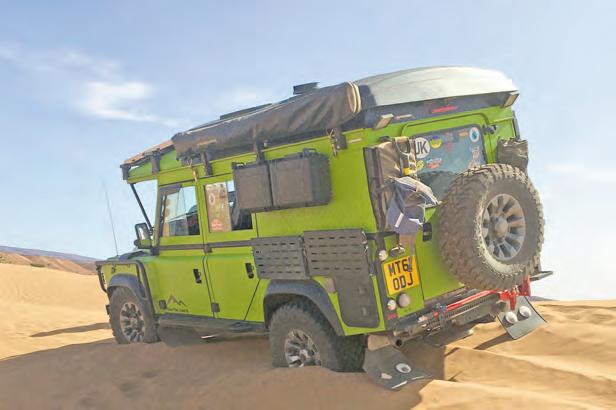










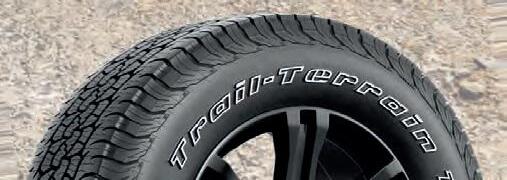

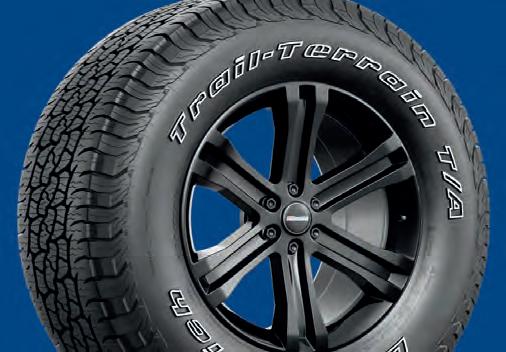







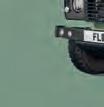

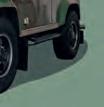
Normally in the world of old Land Rovers, it all hinges on which Series you’ve got. The Series I has originality on its side, of course. But for a usable classic, a 109” Series II/IIA or III takes a great deal of beating.
Series I (1948-1958)

The Series I, particularly in its 80” guise, is the most sought-after of
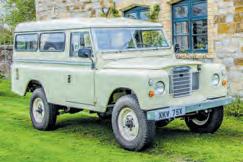
Enthusiasts tend to prefer their Land Rovers with a short wheelbase. But to anyone in the leaf-sprung era who needed one to put to work, especially carrying things, the 109 was the one to go for As always, you could get them in a variety of body styles – van, pick-up, soft-
all Land Rovers. Its engineering and design give it real charisma, but parts aren’t readily available.
Restoration projects require deep pockets, but see it through and the result will be worth mega bucks.
Gone are the days where you could use a Series I as an actual Land Rover. Because with restored examples changing hands
terms, keeping the same 2.25-litre engines throughout the length of its production run.
top, station wagon and even high-cap. In each case, Series II/IIA or III is down to personal preference – the details are different, of course, but it’s the similarities that define them.
There are those who will tell you the II/IIA is a better bet, because the III dates from the British Leyland years and was also affected by the global steel crisis. Be that as it may, it’s the headlights-in-thegrille charm of an early one that’s most
£5000-£85,000
for millionaire money, preservation is the aim of the game.
The earlier the vehicle, the more it will be worth. The sky’s the limit – but can you really put a price on such an icon?
Pros: Heritage, charm, a true classic, the original Land Rover
Cons: Availability of parts, price tag on early 80s

likely to sway you – though any 109 has long since become a much-loved classic.




Insure a 109” Soft-Top with Adrian Flux from £107
• Based on a 1968 2.25 petrol valued at £15,000. Up to 3000 miles per year. 50 year old driver, fully comp, agreed value, £105 excess
Series II/IIA (1958-1971) £2500-£45,000

much of that early charm. Prices are on the increase, however, as these vehicles start to come into their own as collector’s items.
A 2.25 petrol 88” would be our pick, as the diesel engines were underpowered and rather noisy.
The Series II/IIA has a wider stance than its predecessor and adds an extra (thin) layer of
refinement. While the engines have excellent longevity, they need to have been maintained properly. Be thorough in your checks, both under the bonnet and underneath the body.
Pros: A sound investment to restore – and enjoy Cons: Bulkheads and chassis rot, springs prone to seizing
£2500-£15,000
In 1980, the engines switched to a more durable five-bearing crank rather than the old threebearing setup. The transmission also received syncromesh on all forward gears to make it easier to live with.
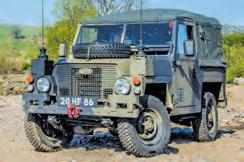
These military vehicles can easily be distinguished from regular
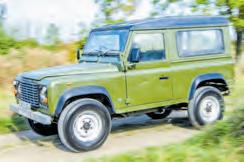
Land Rovers. To mimic the civvy Series machines, the Series III model built from 1972 onwards, also had its headlights switched out to the wings.
Lightweights add an extra dimension to owning a Land Rover. Their military history and details mean you get a truck with more stories to tell – and that stands
They still carry the simplicity of earlier Land Rovers, but can be obtained for a fraction of the price... for now.
Pros: Most affordable way into Series ownership. Still has the Series pedigree. Parts still widely available
Cons: Not yet as desirable as the earlier Series models Series III
out from the crowd. They’re a rare breed, though – so if you’ve got one, it’s worth keeping hold of.
Pros: Not like all the other Land Rovers out there. Military background. Lovely 2.25 petrol
Cons: Appearance isn’t to everyone’s taste. Exclusivity over regular models means they command a price premium
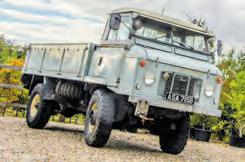
rarity – with all the cachet, pride and immense awkwardness that comes with this status.
By ‘rare’, we’re talking about less than 2500 Series IIA FCs in total. And they tended to have a very hard life, so not many have survived to tell the tale.
Forward-Control models differed from everyday Series IIs by
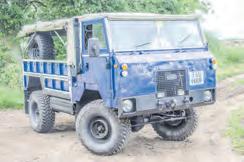
Only ever sold
having heavy-duty ENV axles, but engine-wise they had the familiar 2.25 petrol and diesel lumps. So, don’t expect performance – but do expect to be given an ‘interesting’ time in the workshop…
Pros: A Land Rover like no other, if that’s what you want Cons: Especially brutal to drive, and to find parts
the time came for demob. They were flogged off at very low prices and turned into off-road toys –not something you’d do with one today, given the rarity and classic value they’ve taken on.
Compared to the IIA/IIB FC, the 101 is more fun thanks to its V8 engine. It’s still a military tool,
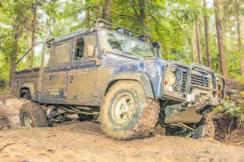
which adds interest. This is a vehicle for enthusiasts, though, with costs that are sky-high even by Land Rover standards.
Pros: Master of the road.
V8 soundtrack. Everybody who sees one loves it Cons:
running costs. Expensive to buy, too






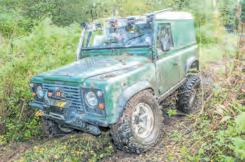
The Tdi engine, which arrived with the Defender name, can last for
decades if it’s looked after. Find one that’s had all its oil changes (a tall order) and it’ll go round (and round) the clock.
The good thing about the earlier 200Tdi is that it’s simpler than the later 300. What you gain here you lose in refinement, but this is seen by many experts as the best Defender of them all.
The LT77 gearbox in the 200 Tdi is more truck-like than the later R380, and these vehicles didn’t come with bling. Just be sure it’s an original Tdi you’re getting, not an old Discovery conversion.
Pros: The perfect combination of tradition and modernity
Cons: Lots of horrible and/or deceptive ones around
Defender 300 Tdi (1994-1998) £4500-£43,000
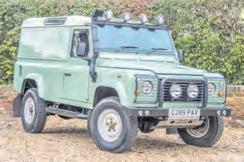
The
the two are related. It’s much more refined and smoother to drive, though there are more electronics involved so later versions in particular are less of a DIY fix.
The arrival of the 300 Tdi also brought with it the R380 gearbox. This used to have a terrible reputation for relability, but most have been put right by now and they’ve

become sought after for their light clutch and better shift action. It was during the Tdi era that Defenders started getting things like alloys, too. You might even find one that’s not been off-road…
Pros: Strength and simplicity.
Perhaps the definitive Defender Cons: Sure to be very different to when it left the factory
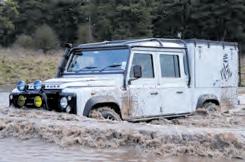
When Land Rover introduced the Defender name, it was actually the
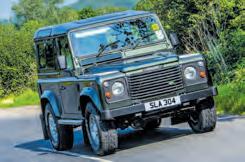
and
130 that changed the most. That’s because unlike the old 127, it was built on a proper chassis of its own rather than a stretched 110 frame.
The advent of the Tdi engine was the making of the 130, too. At last, Land Rover could make them pull properly without returning single-figure fuel economy by using a hard-worked V8.
a strong performer. It does lend itself to being tuned though, so watch out for abused ones and knackered examples that have been pushed beyond the limit.
As with all Defenders, you’ll need a rear crossmember sooner or later – or even a new chassis.




As a result, you’ll find many more original(ish) 130s than 127s. Some are even still in service with the utility companies they were built for.
Despite having more electronics than the Tdi, a Td5 Defender can still be a DIY
The last Defenders gained modern 2.4 and 2.2 TDCi engines and
smooth six-speed gearboxes, They still had phenomenal off-road ability and were even okay to sit in. Famously, this was the Defender that actually had a dashboard Many people dislike the TDCi, especially the earlier 2.4, but they still change hands for huge money – especially when the likes of Kahn or Twisted have been
involed. You will always pay a premium for a Puma, and a Tdi or Td5 may turn out to be a better purchase. Even then, though, look after it and you may well never see depreciation.
Pros: Efficiency, creature comforts, off-road prowess
Cons: Price, electronics, TDCi engine is unloved Defender TDCi (2007-2016) £8500-£195,000
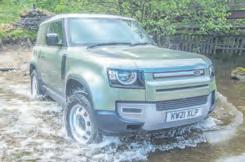
to steer it away on to something safer. Like Brexit, for example.
Much as it may infuriate purists, however, the Defender is actually a very wonderful thing. It’s kind of like an old one, only with space, comfort and equipment.
£55,000-£165,000
making modifications – a market Land Rover wants to take back and have for itself. It won’t hold its value long-term the way an original-shaper does, either. But this is still a superb vehicle.
Pros: Comfort, capability, rugged fitness for purpose
Cons: Not cheap to buy. Lacks the old one’s basic charm Defender (2020-on)
If the subject of the new Defender comes up in enthusiast circles, try






The big difference is that you can’t work on it yourself. This goes for maintenance and, crucially,





















It’s also a notable classic in its own way, as it heralded the start of the company’s modern era. It has its issues, though. The viscous coupling is expensive to replace and can be upset simply by running mismatched tyres.
The 1.8 petrol used to be notorious for head gasket failures. Today’s replacements are much
more robust, but a late diesel is your best bet. Even these can go calamitously wrong, though. This was a more complex car than it needed to be, and buying one for sweeties now doesn’t change that.
Pros: Cheap to buy, no big rust issues, surprisingly able off-road Cons: All sorts of things can go wrong, some very expensively
Range Rover Classic (1970-96) £4000-£275,000

The




2 (2006-2015) £2000-£17,500
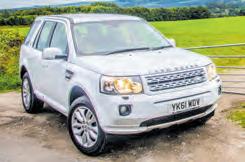
The Freelander 2 was a massive improvement on the model
it replaced. It’s a refined and affordable SUV with a strong engine, good equipment and a decent level of practicality.
It’s become one of the most reliable Land Rovers out there, too.
But do be aware of the rear diff and Haldex unit for costly outlays.
The 2.2-litre diesel engine is a strong performer, though for a
bargain search out one with the unpopular 3.2 petrol unit. Either way, it’s a fine SUV to drive.
Prices have fallen since the production ended, too – £10,000 now gets you one worth having.
Pros: Reliability, refinement, economy of diesel engine
Cons: Transmissions can wear quickly if used for towing
is a classic you can use everyday – and there are people who do just that, preferring to invest new-car money in a restoration than spending it on a current model.
It’s a smart policy, too. An early two-door can cost mega money, but any Classic will appreciate in value if kept in good condition –and sought-after rarities like the CSK and LSE can be a gold mine.
Range Rover (2002-12)
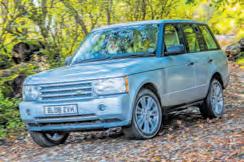
The Mk3 Range Rover hit new heights of luxury and was more re-

The
Range Rover
as
liable than the P38. It’ll still cost a lot to run, however, and drivetrain faults and underbody corrosion are not unknown.
The TDV8 engine is sublime, but you’ll pay more to get one –especially the 4.4, though the 3.6 has all the power you need. The V8 petrol, on the other hand, is temptingly cheap. Guess why…
to greater extremes than ever, with lavish equipment and endless opportunities for personalisation.
It’s a supreme lifestyle wagon for the rich: to many of Land Rover’s traditional fans, on the other hand, it’s the supreme irrelevance.
If you can afford one, few cars could be as pleasing. However if you can afford one and you love
An awful lot of Rangeys have been neglected and/or abused, and you can still buy they cheap. But if you’ve got the skills, and access to parts, restoring one would be the ultimate hobby that pays.
Pros: Most usable classic Land Rover, V8 power, ride quality
Cons: Rust, availability of parts for early models
£2200-£27,000
This isn’t a DIY motor, but it certainly is a Range Rover, with brilliant off-road and towing skills. It relies a lot on electronics, but they work wonders – and the deepdown engineering is very robust.
Pros: Great off-road, luxury, image, TDV8 powerplants
Cons: Very complex. Huge running costs
Land Rovers, you’re likely to be thinking about how many real ones you could buy with this sort of money. It wouldn’t make a bad way to tow your collection about the place, though…
Pros: Immense prestige, and sublime both to be in and drive
Cons: To at least 99% of people it’s utterly divorced from reality
Range Rover Sport (2013-22) £19,500-£140,000

The second-generation Range Rover Sport is 400kg lighter than
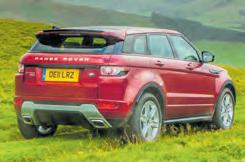
When
the original, meaning it’s almost economical to run. It feels really nimble and agile on the road, too, and it comes with a range of engines giving it a brisk turn of pace. Some won’t like the flamboyant posture, while others will love it. Either way, inside the cabin it’s very nearly as luxurious as the full-fat Range Rover.
the masses. Given that it was the company’s fastest-selling vehicle, they clearly hit the brief, even if it wasn’t for the traditional Land Rover owner.
It’s actually still a capable thing off-tarmac – but it’s definitely more at home on the road.
Nevertheless, it is economical by Land Rover standards and
The only stumbling block with such a fine motor is going to be how to pay for it. Depreciation has started to bring down the purchase price – though you’ll never run one on a shoestring.
Pros: Performance, refinement, glorious interior Cons: Marmite image. Pricey to buy and run
because there are so many out there, used prices are tempting. There’s a Convertible model, too, as well as three and five-door
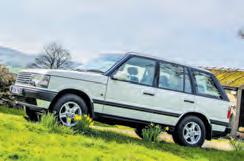
working order is still a sensational car to
own, even today. The problem is that they’re very complex and very, very good at going wrong.
Air suspension failure is the norm. Head gaskets can let go.
Electronics are laughably flaky. And parts can cost the earth – as will the labour bills. Perhaps worst of all, nowadays it’s very hard to find one you can be sure hasn’t
spent at least part of its life being worked on by idiots
Still, you’ll get a classy motor with proper off-road and towing skills. It’s becoming a classic, too, and prices are still tiny considering everything you get.
Pros: Luxury, price, a Land Rover that doesn’t rust Cons: Electrics. Be very afraid
Range Rover (2012-22) £20,000-£150,000

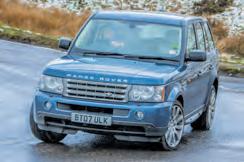
range supply copious amounts of power, and its road manners are absolutely impeccable.
It’s startlingly capable off-road, too, even if getting one muddy would feel like bad form. Most that leave the tarmac probably do so only when their owners are in the mood to blow some grouse out of the sky.
a supreme off-roader as well as being a funky road ride. It doesn’t handle like a sports car, but is agile enough for an SUV.
A Discovery of the same era is far more practical, however, while a full-fat Rangey has more class.
Inside, the Range Rover’s cabin is superb, with sumptuous trim and cutting-edge equipment. Prices are, of course, as immense as the vehicle itself. But if you can afford it, so too is the presence a Rangey will give you.
Pros: Class, luxury, engines, vast all-round capability
Cons: Price
You’re looking at a car which many people associate with rich chavs and criminals, however. And being based on the Discovery 3, it can’t help but share that vehicle’s reputation as a money pit.
Pros: Decent performance and all-round dynamics
Cons: A Disco 3 is more usable. Expect horrific running costs Range Rover Sport (2005-2013) £2500-£20,000
The Sport is mechanically similar to the Discovery 3 – meaning it’s

The Sport is still a massively able tow barge, though, in addition to all its other virtues.
new Range Rover. The Sport is less about being chauffeur driven and more about lording it over other aspirational school runners, but once again it’ll be lovely to drive.
Like the full fat Range Rover (a phrase which has never felt more appropriate), the Sport is available with an old-school V8 engine that gives you racecar performance in

Touch Pro Duo tech and a hike in quality.
The main highlight of the new Evoque is the fact the majority of the range is made up of mild
return for NASA-level emissions. Most UK customers with opt for an altogether healthier plug-in hybrid, but they’ll still get a vehicle that’s brutally fast a well as being able to do the normal Range Rover stuff.
Pros: Smooth, refined, comfy… and game for a laugh, too
Cons: Still hasn’t quite shed its proceeds-of-crime image Range Rover Sport (2022-on) £80,500-£145,000
hybrids, available with diesel and petrol engines combining to an electric motor. Only the base D150 Evoque escapes the electrification,
The current Range Rover is a majestic 4x4. All the engines in the






The Velar a competent cruiser and has received numerous accolades

because of its particularly handsome exterior. It’s based upon the same architecture as the Jaguar F-Pace but has greater off-road ability and is available with a wide choice of engines, most of which combine good economy with usable everyday performance.
The interior is Land Rover’s most advanced cabin to date, with
most reliable units ever. It drives well, too – mated to a manual box it has more guts even than the V8 option, which is surprisingly bland but predictably thirsty.
other models expected to follow the Velar in due course.
But is there a whiff of style over substance? Well, it’s a very good SUV. But you don’t half pay a premium for those suave looks...
Pros: Stylish design, chic cabin, excellent tech features
Cons: Feels like an indulgence, especially at such a high price
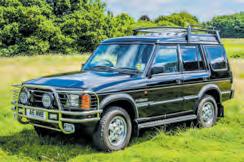
with the same 100” wheelbase and a slick body containing a spacious, flexible cabin. It was well equipped and refined, and it came with the wonderful Tdi engine.
Over time, the Disco’s epic ability meant almost all of them were hammered at playdays. Lower body rust is a big killer, too. So it’s rare to find a good one now,




and when you do they tend to be priced with a lot of optimism.
Very early ones in tip-top condition are full-on classics, too. For a sound one to own, we’d look for a tidy 300Tdi.
Pros: Price, practicality, parts availability. Epic off-road ability
Cons:
been
models had air-suspension, with all the horrors that brings.
Whereas the Disco 1 was prone to body rust, the D2 is fine here. Instead, its chassis rots like a carrot, especially towards the back end. Also at the back, seven-seat

is basically an evolution of the 3. It looks similar and is still a practicality monster, as well as being hugely impressive on and off-road and a hero in front of a trailer, but despite being only subtly tweaked inside feels far more luxurious.
Mainly, D2 owners will tell you about rogue electronics. And leaky sunroofs. They still love their trucks, though, which says a lot.
Pros: Td5 power and reliability, great all-rounder, lots of choice
Cons: Chassis rust, electronics, leaky sunroofs, air suspension Discovery 2 (1998-2004) £1000-£11,000

and capable off-road, genuinely luxurious and a giant of a tow truck, and as well as being able to seat seven adults it can be turned into a van with a totally flat rear load area.
But it was also astonishingly complex, and these days it has a reputation as a money pit.
Air suspension and electronic
handbrakes are big sources of woe, cam belts are a body-off job to change and rust is becoming more of an issue. Get a good one, though, and it’s all the car you’ll ever need.
Pros: Good at everything. Lots of accessories available now
Cons: As fragile as you expect, and then some
start off by buying the best you can possibly afford – and at the top of the market, they don’t come cheap. Get it right, though, and this is as good as a modern Land Rover has ever been.
Somewhere between a facelift and a whole new model, the Disco 4
Pros: Most LR fans’ idea of what a Range Rover should be like Cons: Still a potential money pit, and the best are expensive Discovery 4 (2009-2017) £6000-£30,000
That hasn’t prevented it from suffering all the same issues as time has gone on. You need to

body and dishes up an appealing all-round blend of comfort, kit and general driving manners.The third row of seats is only suitable for little ‘uns, though, and off-road it’s a Discovery in name only.
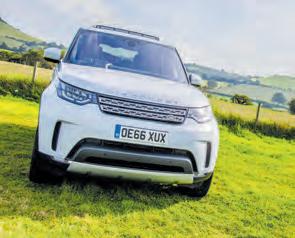
at
launch it was the most capable Land Rover on sale – the new Defender will be going some to wrest that crown from it.
All the engines in the range are refined and flexible, and its chassis is remarkably supple for such a big vehicle. There’s no end of electronics working away in the background, but the effect is very
£24,500-£95,000
convincing – as is an interior that might make you wonder why you’d bother paying more for a Range Rover. Just be careful not to go wild with the options and end up paying more for a Discovery…
Pros: Immense blend of comfort and practicality
Cons: Feels more like a softroader than a proper Discovery
Pros: More practical than an Evoque, and less vulgar. Seven seats. Capable enough off-road Cons: Back seats only for small mammals. Price of top models Discovery Sport (2015-19) £12,500-£33,000
It’s a more practical proposition than the closely related Evoque, and you won’t need to live with the fear of Posh Spice jokes. You


might shudder at the price if you’re buying new, though – but on the used market, there are some tidy looking deals to be had, even on high-spec examples.



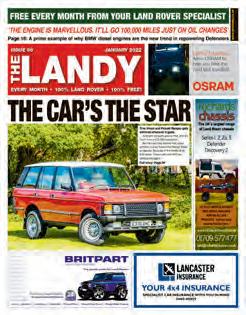

of some models
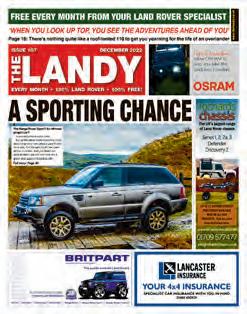

Series I 88” (1958). Full resto. Solid chassis and bulkhead. 2.5 diesel. Higher diff ratios, taller tyres. Interior heater. Comes with capstan winch, metal sun visor and other parts. £18,950. Corby. 07973 656551 08/24/005
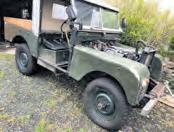
Series I 86” (1955). 200Tdi from 1991 Discovery. Sound condition. Parts thought to be Series I, but gearbox may be Series III. New rad plus some wiring required to finish. Reasonable offers. Anglesey. 07813 298993 08/24/011
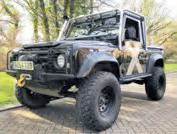
Defender 90 Td5 (2004). 14,700 miles. Overland X model by Nene. 185bhp remap, cage, twin 8274s, ARBs, Ashcroft shafts, extreme suspension, split-charge, snorkel. Bluetooth stereo. £19,999. Cheadle. 07792 132288 08/24/002
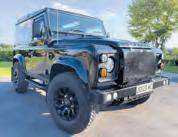
Defender 90 XS (2013). 29,000 miles. Sawtooths, full LED pack, Black Pack, Winter Pack (inc heated screens), NAS rear step. Alpine stereo, custom seats. FSH. MOT May. £32,000. Rugeley. 07464 605139 08/24/007

Defender 90 2.4 TDCi (2007). 122,000 miles. New clutch and flywheel, +2” suspension, cranked rear arms, dislocation cones. Recent Toyo MTs, LEDs, new turbo and exhaust. FSH. £15,995. Ballyclare. 07843 800388 05/24/010


Series IIA 88 (1967). 73,000 miles. 2.25 Diesel. Usable condition, good chassis. Runs and drives. Good steering and tracks straight. Starts every time. Some history and paperwork. £5295. Stonehouse, Glos. 0207 096 5405 08/24/010

Series III 88” 2.25 diesel HT (1983). 61,000 miles. Totally original. Good chassis with new rear crossmember. Good footwells, solid doors. Lovely patina. Only needs some minor love. £7250. Halifax. 07980 064221 05/24/001

Defender 110 2.4 TDCi camper (2011). 175,000 miles. Dormobile roof, Speedwing awning, ARB compressor, 125-litre fuel capacity. Engine rebuilt and mapped. Emu shocks. £21,999. Marldon, Devon. 07522 552611 06/24/004
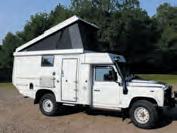
31,500 miles. Converted to camper van by Custom Campers of Germany. Full expedition vehicle ready to travel the world. MOT July. £99,000. Sutton Coldfield. 07425 250590 08/24/008
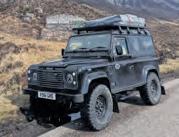
Defender 90 Td5 (1999). New engine Jan 23. £10k repairs and accessories in last 2 years. Terrafirma steering arms, LOF clutch and flywheel, Frontrunner rack. MOT Sep. £14,000. Lincoln. 07944 002998 05/24/011
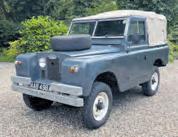
Series IIA (1963). 42,734 miles. 2.25 petrol. Good chassis and bulkhead, rebuilt 5MB engine and carb, new clutch, HT system, fuel tank, props. Parabolics. FWH. Clayton heater. £10,650. Bracknell. 07914 840351 08/24/001

Series III 109” 2.25 petrol. Ex-military. All original. Good chassis, bulkhead will need future work. Roadworthy. Much spent on recent full rewire, tyres and new canvas. £6950. Wadebridge. 07775 593539 05/24/002
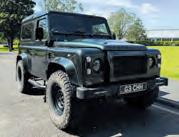
Defender 90 2.4 TDCi (2010). 76,000 miles. Custom grille, wide arches, side steps. Leather seats, heated wheel, ally trim. Alcantara headlining, soundproofing, upgraded stereo. £32,995. Stoke on Trent. 07376 056720 08/24/004
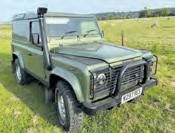
Defender 90 TD5 HT (2000). 148,000 miles. Galv chassis. New turbo at 117,000 miles, new floor pans in 2022. Full respray in 2016. Excellent condition for year. Rare factory colour. £12,500. Bedford. 07766 832605 05/24/008
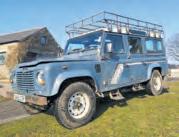
110 CSW project (1989). Galv rolling chassis and bulkhead, refurb axles, 5.9 Cummins (Reece Myers conversion). ZF lorry box. New PAS box, front brakes, HD suspension. Project to complete. £8000. Consett. 07968 176213 05/24/012

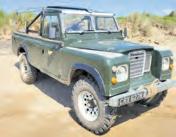
Series III 109 ST (1974). 2.25 petrol. 3-seat cab. Roll bar, winch, towbar. New electric distributor. All lights working except dash illumination. Always starts and drives well. £5500. South Molton. 07983 678373 08/24/006
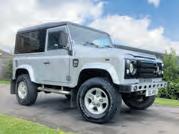
Defender 90 2.4 TDCi (2010). 84,000 miles. Panoramic glass, Red Booster clutch kit, Ashcroft output shaft, Emu shocks, LED headlights, Eberspacher cabin heater. MOT May. £17,995. Rugby. 07740 404574 08/24/009

Defender 90 Pick-Up (2012). 36,500 miles. Tuned 2.2 TDCi. Many Bowler parts. KBX grille, Lazer LED bar. Uprated brakes, Terrafirma shocks. Excellent condition. £39,995. Waltham Abbey 07958 372618 05/24/006
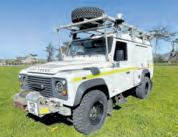
Defender 110 2.4 TDCi Utility (2011). 157,427 miles. Recent clutch, turbo, transfer case. Exterior lights, adjustable towbar, 7-pin plug, Maxxis 764 Bighorn MTs. MOT Sept. £8995 + VAT. Pwllheli. 07450 654988 06/24/005

Defender 110 Utility (1997). 198,000 miles. Galv chassis, engine

Pre-Production Suffix A Range Rover (1970). Requires full resto. Dry stored since 1988. 3rd Range Rover built, was loaned to Royal family. Comes with collection of parts. £45,000. Hebden Bridge. 07760 772263 08/24/003

Series III Lightweight (1972). 2.5 diesel. Galv chassis, new doors and door tops, military hitches, four rear seats. Well maintained and reliable. First registered 1981. £11,500. Holsworthy. 07861 741441 05/24/007
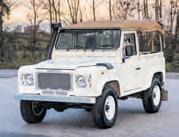
Defender 90 Td5 Heritage (2005). 165.000 miles. Three owners from new. Remote locking, electric windows, FM stereo, LEDs, brand new battery in Feb ’24. Part history. MOT April. £15,000. Hereford. 07714 614567 05/24/005
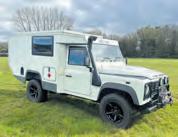
Defender 110 2.4 TDCi camper (2007). 124,500 miles. HD susp. LEDs, Grabbers, 13,500lb winch. Double-height pop-top, fridgefreezer, hob, 60-litre water tank, split-charge. £36,995. Billericay. 07715 591541 06/24/001

Defender 110 Td5 HT (1999). 91,000 miles. Three-seater. Front and rear heated windows, 1000W 12V inverter, Eberspacher diesel heating system, reversing camera. £15,500. Whitchurch, Hampshire. 07725 819365 06/24/003
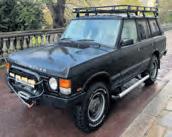
Range Rover Vogue 3.9 V8 auto (1993). 147,000 miles. LHD. Full specialist restoration. Leather seats, alcantara dash, sunroof, upgraded stereo. 2 owners. Excellent history. £17,500. London. 07999 990070 05/24/003

Range Rover monster truck (1973). Suffix A chassis, genuine 92/93 2-door shell. 5.7 Chevy V8 (new in 04), 4-speed auto, modded axles, custom props. 49.00x21R20 Swampers. £22,500. Westerham. 07707 449916 06/02/002




‘The Hindon’ by Heritage 1948 has been developed after customer demand for a 15” Wood Rim Wheel with a Satin Black Anodised Body. 'The Hindon’ joins our ever growing range of exceptional quality wheels.
The Hindon 15” Wood Rim by Heritage 1948 has been developed around the classic spirit of the Land Rover and continues our uncompromising commitment to quality aftermarket parts. The Satin Black Anodised Body of the Steering Wheel is forged from durable 6061 Billet Aluminium. This is contrasted by a crafted Beech Wood Rim and nished o with 9 Polished Structural Metal Rivets. A Steering Wheel guaranteed to improve the interior of any Land Rover Series or Defender.
Heritage Wood Rim Steering Wheel 6061 Billet Aluminium
Beech Wood Rim Black Anodised Body 48 & 36 Spine Boss Kits
Product Code: HER-WH-05
+44 (0) 1948 545132
INFO@HERITAGE1948.CO.UK
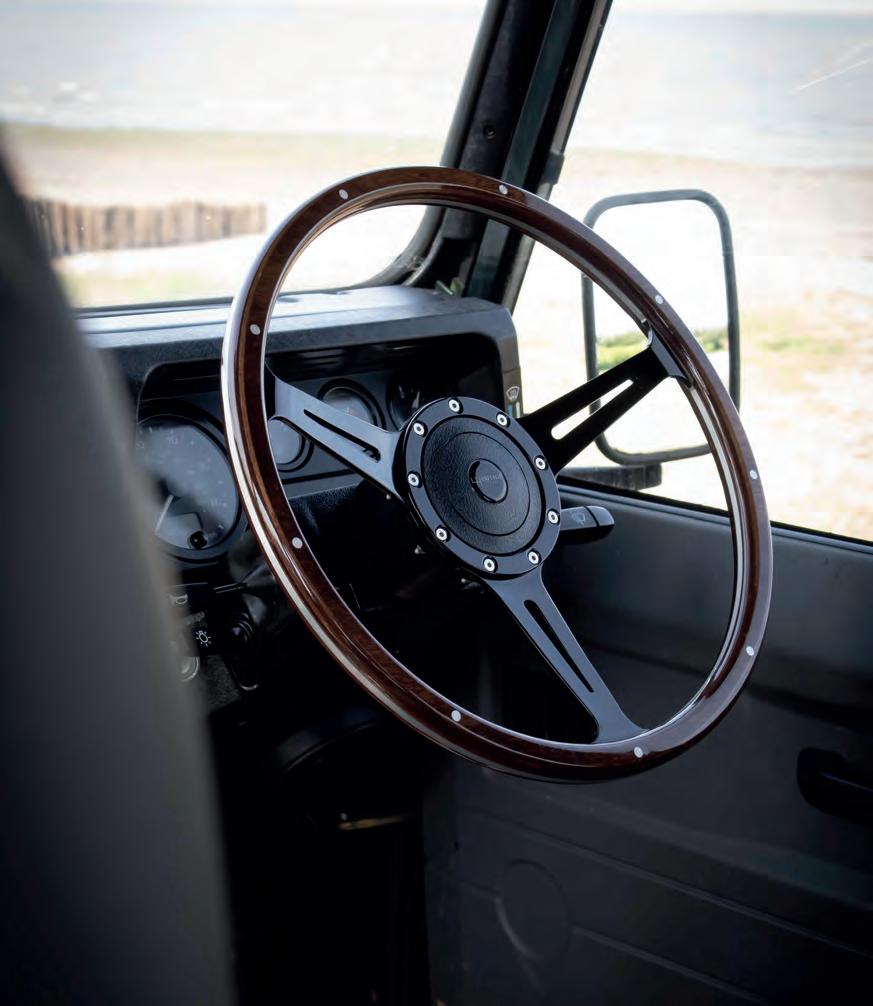

Heritage 1948 is dedicated to producing a range of outstanding quality Canvas Hoods for Series Land Rovers. Unlike some of our competitors, all of our Land Rover Hoods are handmade in our Somerset factory from superior quality ‘Moorland’ Canvas.

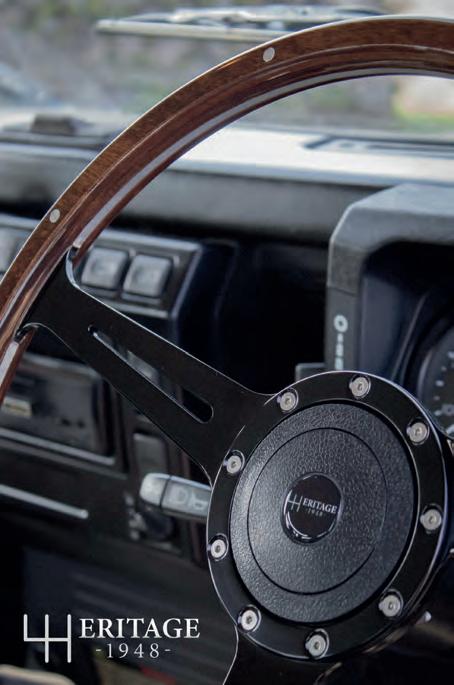
Our handmade Hoods are inherently more accurate than machine produced counterparts, allowing for an enhanced t and exceptional quality control. Heritage 1948 has taken great care to ensure all our Land Rover Hoods have an enhanced life span and are all nished with period correct Solid Brass ttings.

